Home Decor
How to Repurpose a Dresser Into a Bookshelf
Discover how to breathe new life into an old dresser, transforming it into a functional and stylish bookshelf that's both eco-friendly and budget-friendly.
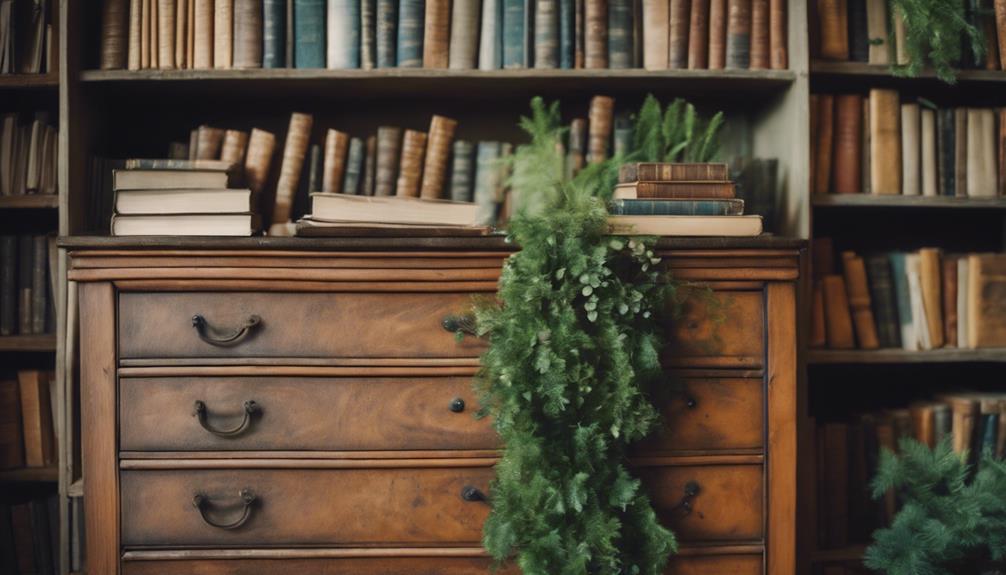
We're about to breathe new life into an old dresser, transforming it into a functional and stylish bookshelf that's both eco-friendly and budget-friendly. To get started, we'll assess the dresser's dimensions and condition, identifying weaknesses or damage to guarantee sturdiness and stability. Next, we'll modify the top section, trimming excess depth and maintaining structural integrity. By adjusting the height and adding new shelves and back panels, we can create a functional bookshelf that's tailored to our needs. With some TLC and creativity, we'll reveal the full potential of this upcycled dresser – and discover a unique piece that's truly one-of-a-kind.
Key Takeaways
• Assess the dresser's condition, identifying weaknesses and ensuring sturdiness before modification.
• Carefully remove and refine the top section, trimming excess depth for a clean cut.
• Adjust the height and add or modify shelves to achieve the desired functionality and aesthetic.
• Apply wood stain and finish evenly to achieve a durable and glossy finish.
• Ensure stability and balance by leveling shelves, adding felt pads to feet, and anchoring to the wall if necessary.
Prepare the Dresser for Conversion
Before we begin transforming our dresser into a bookshelf, we need to evaluate its potential by examining its dimensions and overall condition. This old dresser may have seen better days, but we can still rejuvenate it. We'll assess the part of the dresser that's still sturdy and decide what can be repurposed. It's crucial to examine the dresser's size and shape, making sure it fits the intended space and aligns with our aesthetic goals. We might need to adjust its height or depth to create a more compact bookshelf.
As we inspect the dresser, we'll identify any weaknesses or damage that require attention. We'll check for sturdiness and stability, ensuring it can support the weight of our books and decorations. By doing so, we'll guarantee our bookshelf is safe and functional.
This evaluation process will help us determine the best approach for our dresser-turned-bookshelf project. With a clear understanding of our dresser's capabilities, we can move forward confidently, prepared to unlock its full potential.
Remove and Refine the Top Section
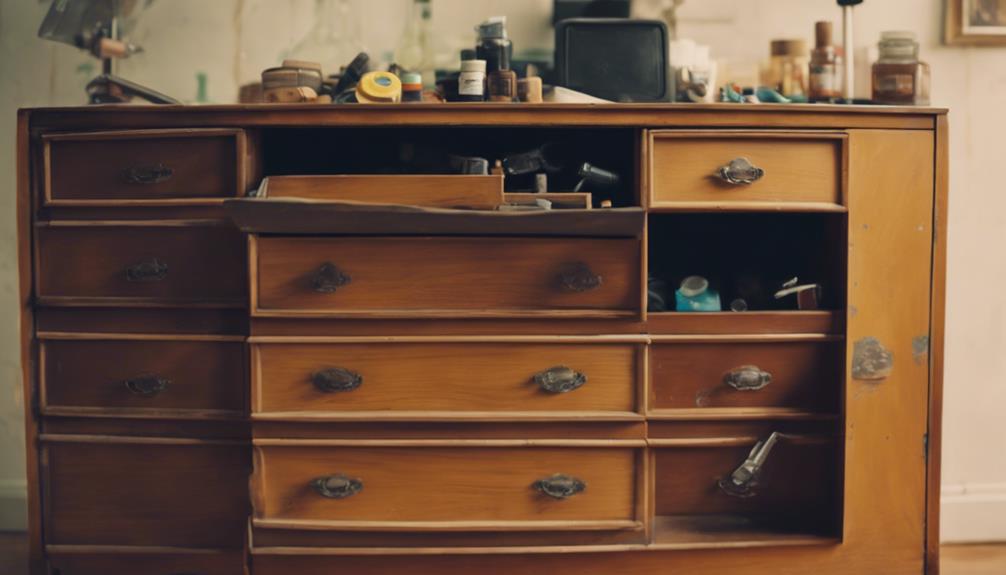
We carefully pry off the top section of the dresser, taking care not to damage the surrounding structure, and set it aside for further modification. This pivotal step lets you know that the transformation from dresser to bookshelf has officially begun.
As we refine the top section, we're mindful of the dresser's original purpose – a piece of furniture designed to hold delicate items. We're now repurposing it to hold books, decorative items, and other knick-knacks that will adorn our living room.
To achieve a polished look, we take our time to carefully trim down the excess depth of the dresser, ensuring a clean cut that maintains the structural integrity of the piece. We measure twice and cut once, avoiding unnecessary adjustments or mistakes.
As we work, we're aware that every detail counts in creating a sturdy and durable bookshelf. With patience and attention to detail, we're one step closer to creating a beautiful, functional piece of furniture that will be the centerpiece of our living room.
Adjust the Height and Shelves
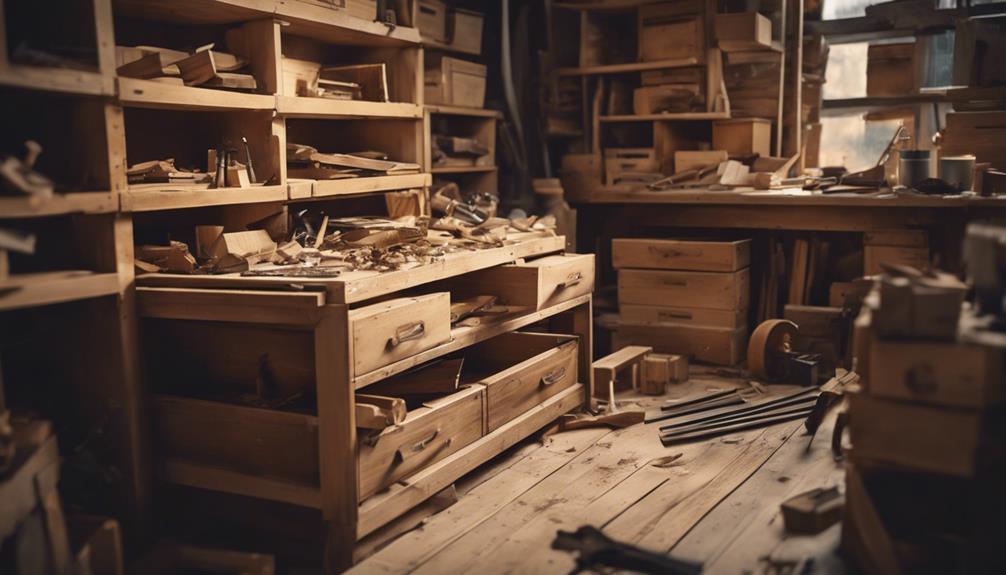
With the top section refined, we turn our attention to adjusting the height of our dresser-turned-bookshelf, an essential step in creating a functional and visually appealing piece of furniture. This process requires careful consideration to guarantee our repurposed dresser meets our storage needs and fits seamlessly into our desired space.
To achieve the perfect height, we'll need to carefully remove the top and cut off excess depth to achieve the desired size. This won't only improve the overall aesthetic but also create a more functional storage space.
Some key considerations for adjusting the height and shelves include:
- Retaining existing shelves or adding new ones to create functional storage spaces within the bookshelf
- Considering adding a middle shelf for additional storage and display options
- Using existing materials or repurposing leftover paneling to create new back panels for the bookshelf
- Making sure the final touches, such as applying felt pads to the feet, for a finished and functional repurposed dresser bookshelf
Add New Shelves and Back Panels
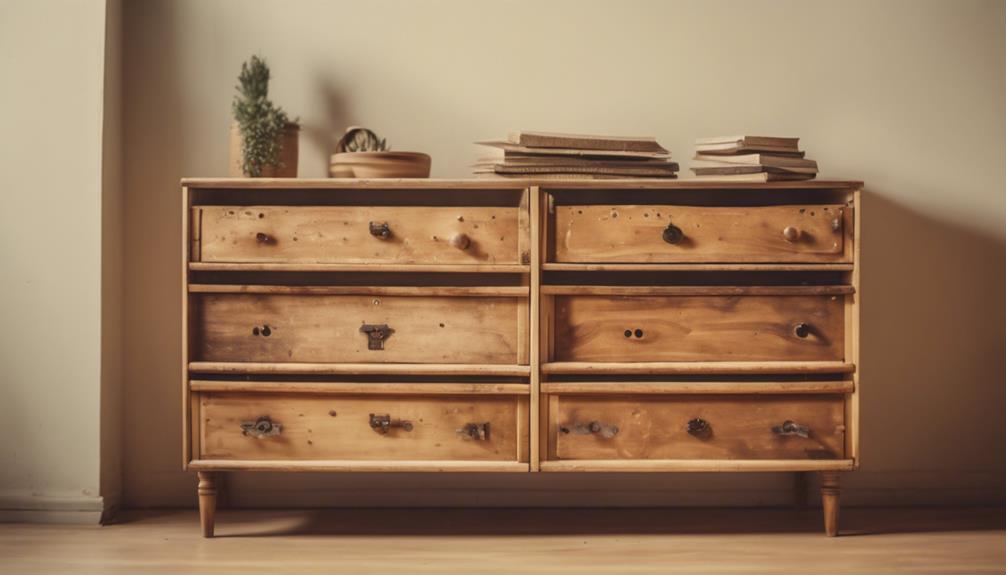
As we progress with repurposing our dresser into a bookshelf, we need to contemplate the arrangement of our new shelves and the design of our back panels.
We'll explore the various options for shelf arrangement, taking into account the types of items we plan to store and our personal design preferences.
Shelf Arrangement Options
We'll start by evaluating our dresser's internal architecture to determine the best placement and design of new shelves and back panels that suit our desired bookshelf functionality. This vital step allows us to maximize storage capacity while maintaining the overall aesthetic appeal of our repurposed dresser.
By adding new shelves and back panels, we can create a unique and functional bookshelf that meets our specific needs.
Here are some shelf arrangement options to explore:
- Customizable shelf heights: Experiment with different shelf heights to accommodate various item sizes, ensuring a snug fit and efficient organization.
- Symmetrical or asymmetrical designs: Choose a balanced or unbalanced layout to add visual interest and create a distinctive focal point.
- Fixed or adjustable shelves: Decide between fixed shelves for a more permanent design or adjustable shelves for flexibility and adaptability.
- Open or closed shelving: Opt for open shelving to display decorative items or closed shelving for a more streamlined appearance.
Back Panel Design
We add depth and visual appeal to our repurposed dresser bookshelf by designing and installing back panels that provide stability and a finished look.
These back panels not only enhance the aesthetic of our project but also provide additional support to the shelves, ensuring they can hold a decent amount of weight.
When creating back panels, we can repurpose leftover wood or paneling, reducing waste and adding a touch of sustainability to our project.
By utilizing the dresser's existing structure, we can incorporate additional shelves and back panels, securely attaching them for both functionality and aesthetics.
A well-designed back panel can elevate the entire look of our repurposed dresser bookshelf, providing a cohesive and polished finish to the project.
With the added storage capacity and organizational options, we can maximize the functionality of our repurposed piece, making it a valuable addition to any room.
Stain and Finish the Bookshelf
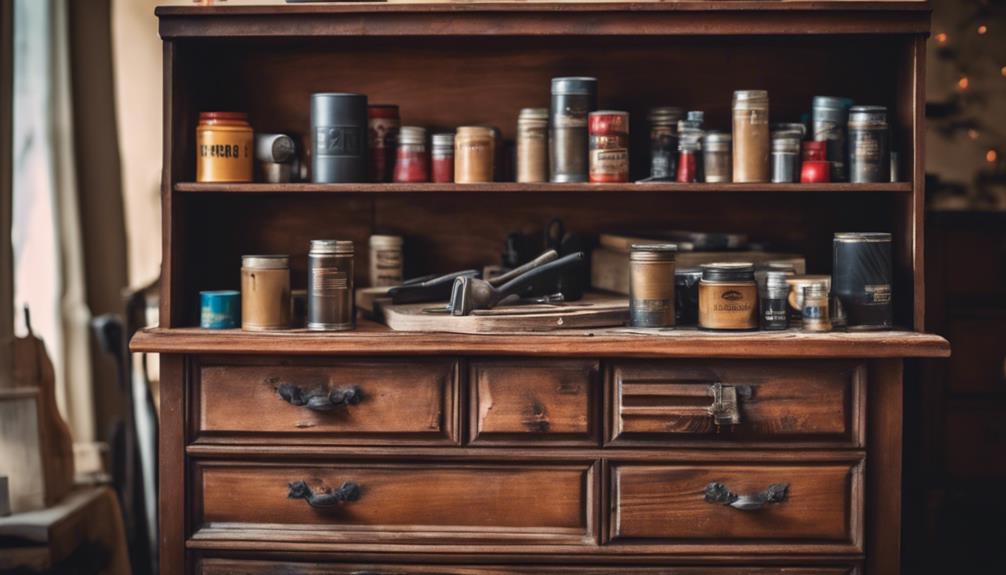
We're ready to bring out the beauty of our repurposed dresser by applying a rich, even coat of wood stain. This step is important in enhancing the natural beauty of the wood and creating a cohesive look for our bookshelf. To achieve a professional finish, we'll follow some essential guidelines.
Here are the key takeaways for staining and finishing our bookshelf:
- Apply a coat of wood stain evenly to enhance the natural beauty of the dresser-turned-bookshelf.
- Make sure the stain is completely dry before adding a protective finish like shellac or polyurethane.
- Use a clean brush or cloth to apply the shellac in smooth, even strokes for a professional look.
- Allow the shellac to dry thoroughly between coats to achieve a durable and glossy finish.
Add Protective Feet and Position
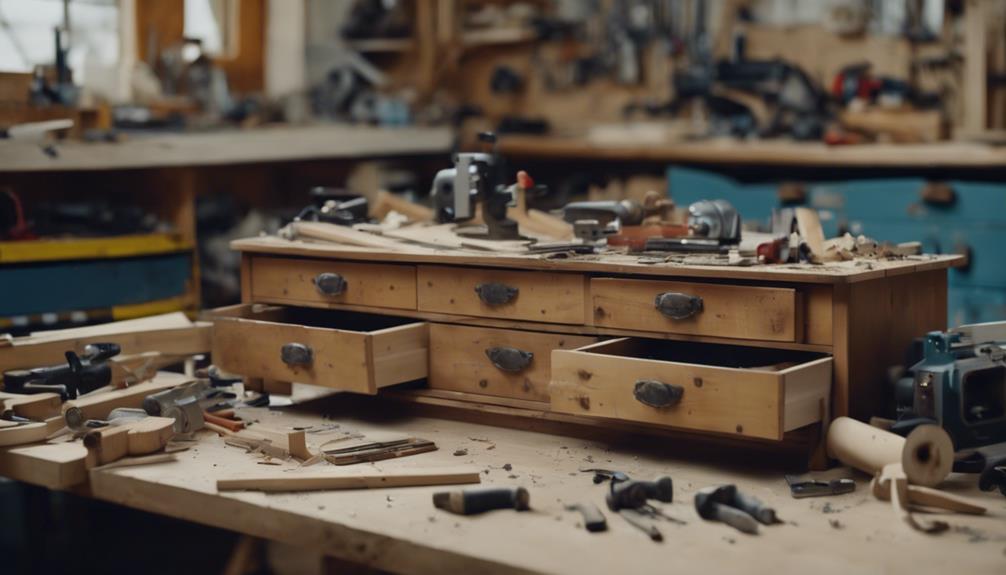
As we approach the final stages of repurposing our dresser into a bookshelf, we'll need to guarantee it's stable and secure.
To do this, we'll add protective feet to prevent scratches and marks on our floors and then level the shelves properly to prevent any wobbling or tipping.
Secure the Furniture Base
Let's add felt pads to the bottom of the dresser feet to protect our floors from scratching and scuffing. This simple step can save us from costly repairs and unwanted marks on our floors.
Once we've added the felt pads, we can position our repurposed dresser bookshelf in a corner or against a wall for added stability.
Here are some key considerations to keep in mind when securing our furniture base:
- Position the bookshelf in a well-lit area for easy access to books and items on display.
- Consider anchoring the dresser to the wall for extra safety, especially if we've children or pets at home.
- Make sure the bookshelf is level and sturdy to prevent it from tipping over.
- Check the weight capacity of the dresser to confirm it can hold the weight of our books and decor items.
Level the Shelves Properly
Now that our furniture base is secure, we'll focus on leveling the shelves to guarantee our repurposed dresser bookshelf is stable and functional.
To achieve this, we'll use a level to make sure that the shelves are properly aligned and balanced for stability. We'll also add felt pads to the bottom of the dresser feet to protect our floors from scratches and damage.
Once the shelves are level, we'll position the bookshelf in a corner or against a wall to maximize space and create a functional display area. For added safety, especially if our bookshelf is tall or heavy, we'll consider anchoring it to the wall.
Prevent Scratches and Marks
We'll take an essential step in preserving our floors by adding felt pads to the bottom of the dresser feet, ensuring our repurposed bookshelf doesn't leave unsightly scratches or marks. This important yet necessary step will save us from the hassle of repairing damaged floors or walls.
To further prevent scratches and marks, we'll consider the following:
- Position the bookshelf in a stable location away from high traffic areas to minimize movement.
- Use furniture sliders under the feet for easy repositioning without damaging floors.
- Apply adhesive rubber pads on the back corners of the dresser to prevent wall damage.
- Regularly check and replace protective feet to maintain the bookshelf's integrity and prevent damage.
Final Touches and Installation
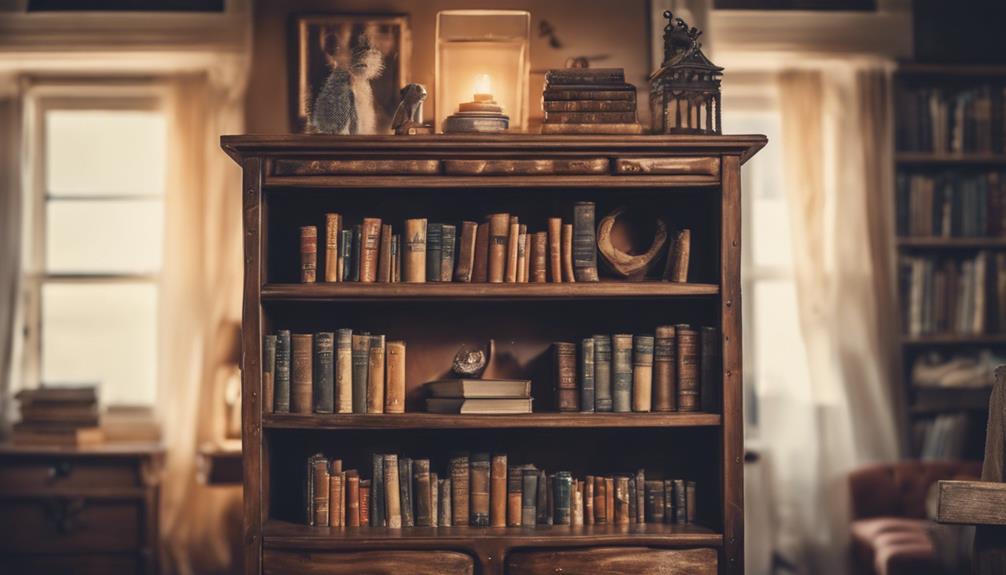
With the repurposed dresser's transformation nearly complete, we applied felt pads to its feet to prevent scratching or damage to the flooring, ensuring a seamless integration into our living space.
This thoughtful detail allowed us to confidently place the bookshelf in a corner of our living room, where it now serves as a functional and stylish addition. We then filled the shelves with photo albums, which now have a beautiful new home.
What's more, we achieved this transformation without incurring any additional expenses, solely utilizing materials we already had on hand.
As we step back to admire our handiwork, we're thrilled to see how the repurposed dresser bookshelf has blended seamlessly into our living space, striking a perfect balance between functionality and aesthetics.
Frequently Asked Questions
Can You Turn a Dresser Into a Bookcase?
"We've wondered if an old dresser can be transformed into a bookcase, and the answer is yes! With some creativity and DIY skills, we can give new life to an old piece of furniture."
How to Make Shelves Out of Dresser Drawers?
We're excited to turn dresser drawers into shelves! We'll remove them, measure the frame, and attach them horizontally, ensuring a snug fit. Then, we'll secure them with brackets or screws, and finally, arrange them at varying heights for a unique look.
How to Repurpose an Old Dresser?
"We're excited to breathe new life into an old dresser! We'll assess its condition, imagine its potential, and decide on a repurposing plan, whether it's a bookshelf, bench, or something entirely unique."
How to Turn a Dresser Into a Toy Box?
We're excited to transform an old dresser into a toy box, and we're starting by removing drawers and shelves to create a spacious interior, then sanding it down for a smooth finish.
Conclusion
As we stand back to admire our handiwork, we can't help but feel a sense of pride and accomplishment, much like a Renaissance-era artisan gazing upon their latest masterpiece.
Our once-humble dresser has been transformed into a sturdy bookshelf, ready to hold the weight of our favorite tomes.
With a few simple modifications and a dash of creativity, we've given new life to an old piece of furniture, proving that with a little bit of elbow grease, anything is possible.
Home Decor
Blend Modern and Traditional Decor Like a Pro – Discover the Secrets!
Learn how to seamlessly blend modern and traditional decor for a stunning space that reflects your unique style—discover the secrets inside!
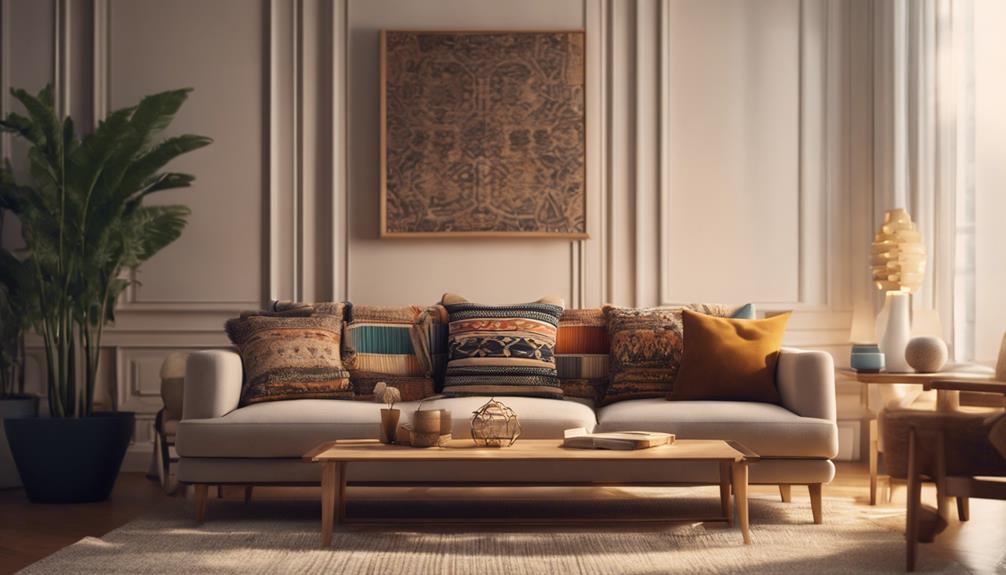
Blending modern and traditional decor is all about balance and intent. Start by selecting complementary furniture that enhances both styles, like a sleek modern coffee table paired with an ornate traditional sofa. Focus on a cohesive color palette to unify the look, and mix textures for a dynamic appeal. Choose art that bridges the gap between the two styles, ensuring it fits the context of your space. Don't forget about functional pieces, as they add purpose and charm. Discovering more techniques will elevate your decor game, making it just the kind of space you've always wanted!
Key Takeaways
- Combine sleek modern pieces with ornate traditional furniture to create aesthetic balance and visual contrast.
- Use a cohesive color palette and varied textures to seamlessly integrate modern and traditional styles.
- Select functional furniture that enhances usability while blending design elements from both styles.
- Incorporate art that bridges modern and traditional aesthetics for a harmonious visual appeal.
Understanding Furniture Styles
To create a harmonious space, you need to grasp the differences between modern, contemporary, and traditional furniture styles.
Modern furniture, emerging from the mid-20th century, showcases clean lines and functional design, often prioritizing simplicity and minimalism. Think of iconic pieces that reflect this era, like Eames chairs or sleek coffee tables.
In contrast, contemporary furniture lacks a definitive timeline and can sometimes feel bloated, incorporating trends that may not age well.
Traditional pieces, on the other hand, encompass historical styles such as Chippendale, Victorian, and Gustavian. These designs celebrate intricate details and craftsmanship, providing a sense of warmth and history to your decor. Understanding these distinctions is essential for blending styles effectively.
When you know the characteristics of modern furniture versus traditional pieces, you can create a balanced look that honors both aesthetics. For instance, pairing a sleek modern sofa with ornate traditional accent chairs can create a striking visual contrast that feels intentional rather than mismatched.
Techniques for Blending Decor
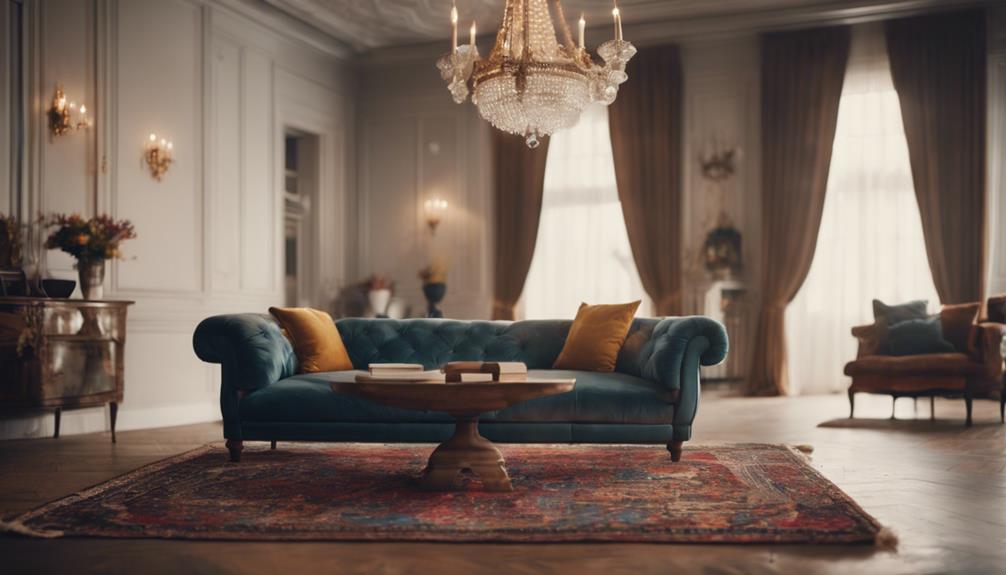
When blending modern and traditional decor, focus on choosing complementary furniture that enhances both styles.
Pay attention to color and texture harmony to create a seamless changeover between the two aesthetics.
With the right mix, you can achieve a space that feels balanced and inviting.
Complementary Furniture Choices
Blending modern and traditional decor calls for carefully selecting furniture that balances sleek lines with ornate details. A modern coffee table can serve as a versatile centerpiece, complementing traditional sofas and chairs while creating a harmonious blend of styles.
When mixing furniture, pair sleek, minimal modern pieces with more ornate traditional items to enhance aesthetic balance without overwhelming your space.
Consider incorporating contemporary accent pieces, like modern art or lighting fixtures, to elevate traditional settings and add a fresh touch. Functional furniture choices, such as modern side tables alongside traditional couches, create visual interest while keeping practicality in mind.
This approach not only enhances the overall design but also guarantees comfort and usability.
Color and Texture Harmony
Creating harmony between modern and traditional decor hinges on a cohesive color palette and a thoughtful mix of textures that complement each other seamlessly.
Start by selecting a color scheme that includes both modern and traditional hues, ensuring they work well together. This will create a smooth shift between styles.
To enhance the balance of color and texture in your space, consider these techniques:
- Choose a cohesive color palette that unites modern and traditional shades.
- Incorporate various textures by pairing sleek modern finishes with rich, traditional fabrics.
- Use area rugs that blend modern patterns with traditional designs to anchor the room.
- Select decorative pieces like cushions or throws featuring a mix of contemporary and classic patterns.
Key Elements for Integration
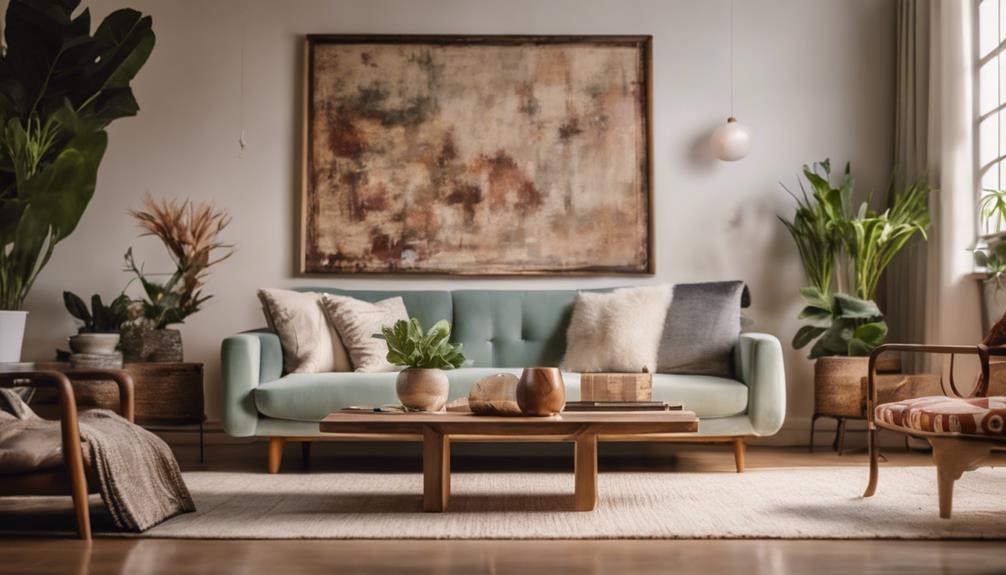
To successfully integrate modern and traditional decor, focus on finding complementary pieces that enhance the overall aesthetic without overwhelming the space.
Start by incorporating functional furniture that serves a purpose while adding style. For instance, a sleek modern coffee table can anchor your living room, harmonizing with classic sofas or armchairs.
Next, pay attention to your art selection. Choose pieces that bridge the gap between both styles, like abstract modern art alongside traditional landscapes. This combination adds depth and interest, creating a dynamic focal point that resonates with both aesthetics.
Maintaining an aesthetic balance is essential. Avoid overly stylized modern pieces that clash with traditional designs. Instead, aim for a cohesive color palette that ties everything together, ensuring that each element feels intentional.
Minimal decor can also help to integrate modern accents into traditional settings, promoting a unified look.
Architectural Context and Design
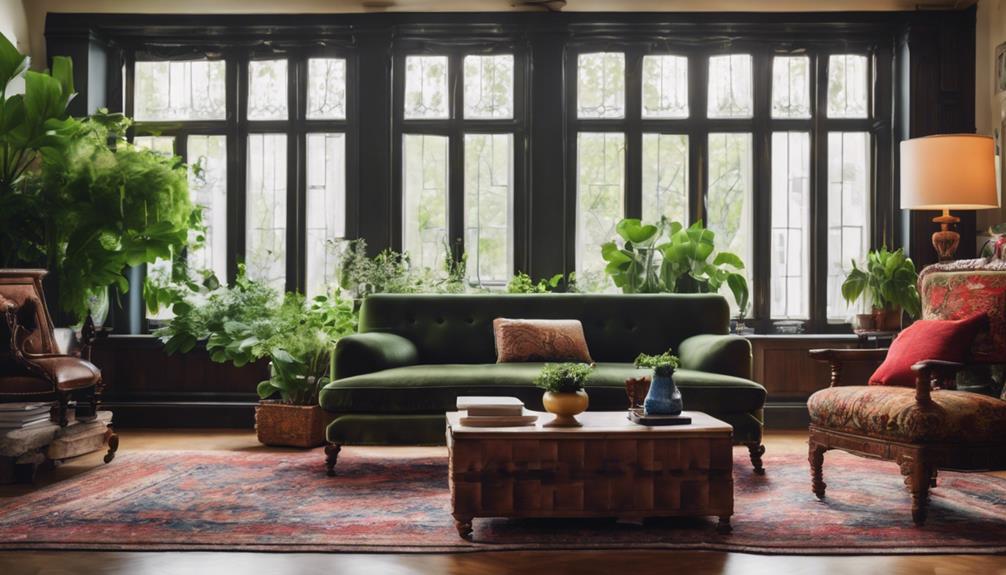
How does the architectural context of a space influence your choices when integrating modern and traditional decor? The features of a room, like high ceilings and ornate moldings, play a pivotal role in guiding your interior design decisions. When you understand the architectural context, you can seamlessly blend styles without overwhelming the space.
Here are some key considerations to keep in mind:
- Embrace traditional backdrops: Traditional architecture can beautifully showcase modern accents.
- Complement existing elements: Choose modern pieces that enhance, rather than compete with, traditional features.
- Avoid tackiness: In unique spaces like a 1960s ranch, verify modern selections align with the home's original design.
- Focus on cohesion: Aim for a harmonious coexistence of styles to maintain visual interest.
Shopping for Blended Styles
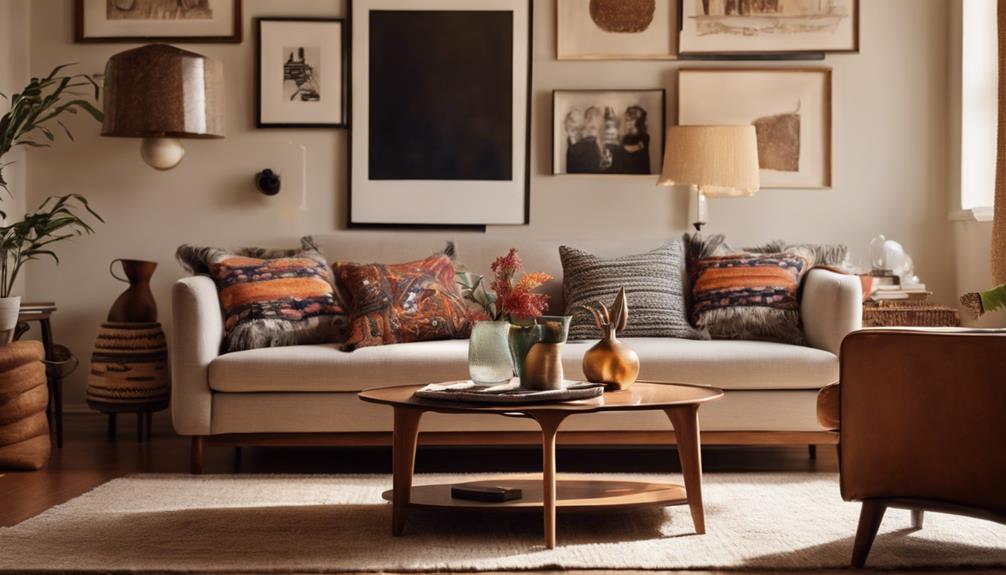
When you're shopping for blended styles, knowing where to look makes all the difference.
Retailers like Anthropologie and West Elm offer curated collections that seamlessly combine modern and traditional decor.
Plus, online shopping opens up a world of options, allowing you to find unique pieces that fit your aesthetic effortlessly.
Retailer Recommendations
Shopping for blended styles is a breeze with retailers like Anthropologie and West Elm, which offer curated collections that effortlessly mix modern and traditional decor.
You'll discover home furnishings that are mostly modern but include timeless elements to create a harmonious aesthetic in your space. Here are some recommendations to get you started:
- Explore Anthropologie's unique furniture and decor that features eclectic designs.
- Check out West Elm for sleek, contemporary pieces paired with classic accents.
- Consider wallpaper and wall murals from these retailers to unify your decor theme.
- Browse online shopping platforms for a variety of neutral and colorful options that allow for personalization.
These retailers not only provide a diverse range of options but also make it simple to find pieces that complement each other beautifully.
As you shop, keep in mind the balance between modern and traditional elements to achieve a cohesive look that reflects your personal style.
Enjoy the process of blending styles and creating a space that feels uniquely yours!
Online Shopping Tips
To successfully blend modern and traditional styles, start by exploring curated online collections that showcase unique pieces from retailers like Anthropologie and West Elm. These platforms offer a mix of furniture that can truly help your space look good. When online shopping, utilize filters to narrow down your search by style, color, and material, ensuring you find items that harmonize with both aesthetics.
Don't forget to check customer reviews and photos. They provide valuable insights into how various styles can work together in real-life settings, guiding your decisions. Additionally, consider the shipping and return policies of online stores. This way, you can make risk-free purchases and experiment with different furniture styles in your home without worry.
Engaging with design blogs and social media platforms can also offer tips and inspiration on blending modern and traditional decor effectively. You'll discover unique ideas and pieces that resonate with your vision.
With these online shopping tips, you'll be well-equipped to create a space that seamlessly combines both styles and ultimately looks good. Happy shopping!
Curated Collection Insights
Curated collections from retailers like Anthropologie and West Elm make it easy for you to discover pieces that seamlessly blend modern and traditional styles in your home. These collections offer a curated selection that allows you to find unique items while ensuring they harmonize with your existing decor.
Here are some insights to reflect on when shopping for blended styles:
- Look for furniture that features a mix of neutral and colorful tones.
- Explore wall murals and wallpaper to enhance your decor and tie themes together.
- Combine classic and modern fusion styles to create depth in your design.
- Pay attention to textures and materials that bridge the gap between traditional and contemporary.
With the right curated collection, you can elevate your home's aesthetic by incorporating traditional elements alongside modern pieces. By thoughtfully selecting items that complement each other, you'll create an eclectic and inviting atmosphere that reflects your personal style.
Inspiration From Eclectic Interiors
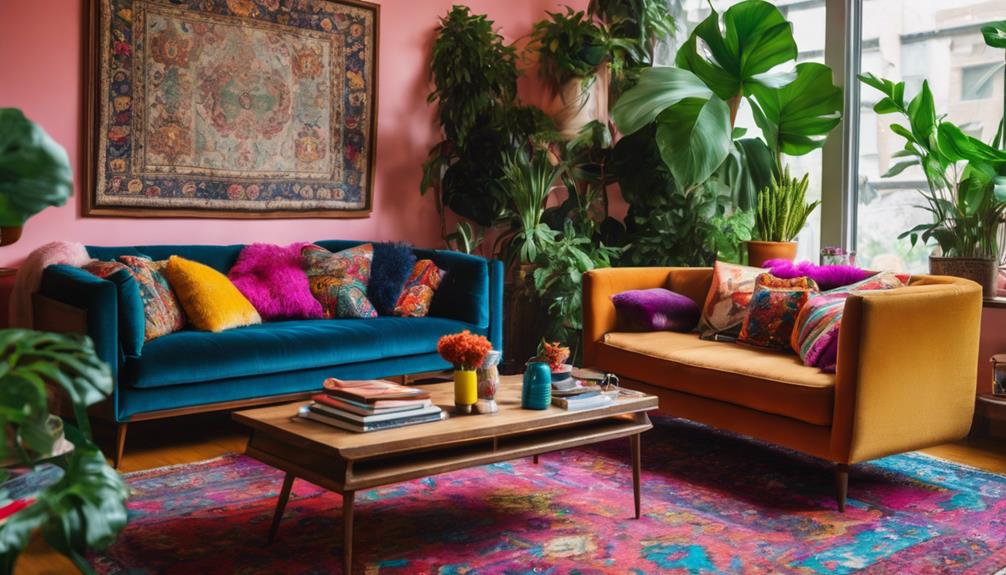
Exploring eclectic interiors reveals how seamlessly mid-century pieces can enhance traditional decor, offering endless inspiration for your home. By incorporating mid-century modern elements into a mostly traditional setting, you can create a unique aesthetic that captures attention and showcases your personality.
Consider how Scandinavian designs effectively showcase mid-century pieces alongside traditional elements. They emphasize simplicity and functionality, making them a perfect fit for various styles. Parisian interiors, on the other hand, highlight versatility by integrating mid-century cabinets with modern furnishings, proving that mixing styles can be both practical and visually appealing.
To illustrate the balance of these styles, take a look at the table below:
| Style Element | Description |
|---|---|
| Mid-Century Chairs | Lighter, sculptural designs |
| Traditional Furniture | Heavier, classic pieces |
| Color Palette | Consistent tones to unify the space |
| Placement Strategy | Pairing lighter items with heavier ones |
This thoughtful placement can elevate your room's atmosphere and create a sense of balance. Embrace these eclectic inspirations to transform your space into a harmonious blend of modern and traditional decor.
Essential Pieces for Harmony
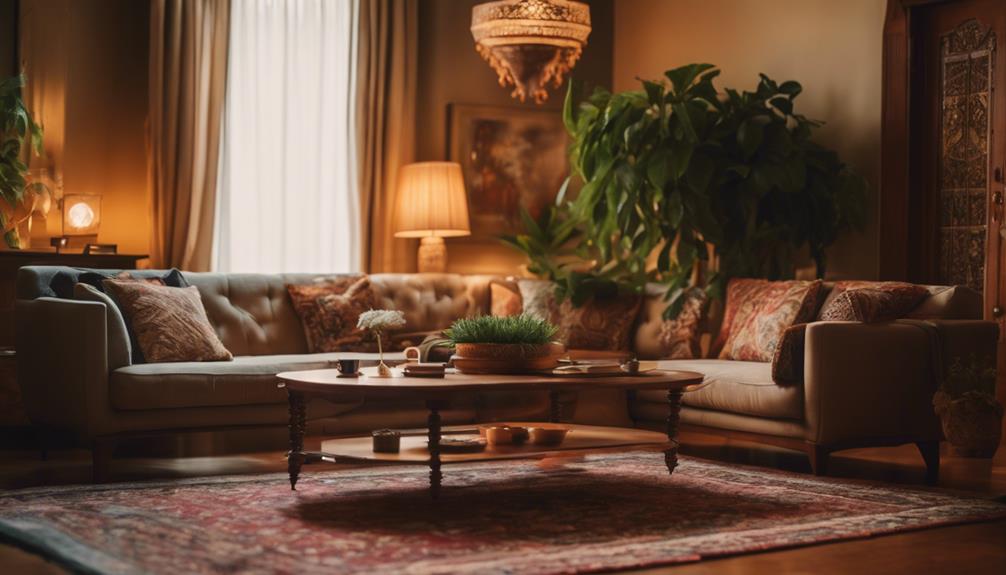
Finding the right essential pieces is key to achieving harmony between modern and traditional decor in your home. These elements can bridge the gap between styles, creating a cohesive and inviting look.
Here are some must-have pieces to contemplate:
- Mid-century chairs: They can enliven traditional spaces with their visual contrast and modern flair.
- Noguchi coffee table: This sculptural focal point harmonizes beautifully with both modern and traditional furnishings.
- Functional modern side tables: Placing these alongside traditional pieces maintains practicality while blending styles.
- Rugs: Use rugs like oriental or natural fibers to unify various furniture styles and define your spaces.
Creating Timeless Spaces
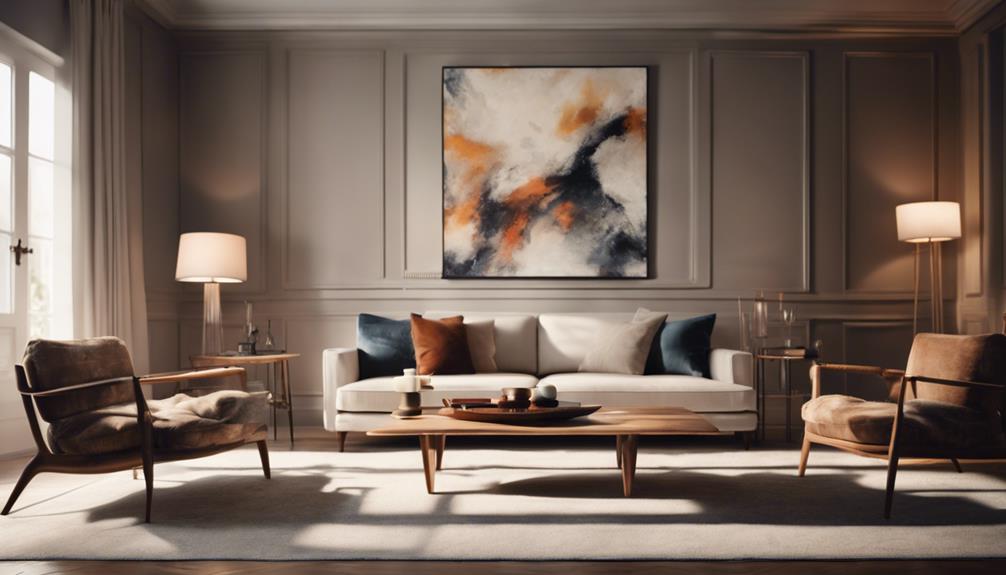
Creating timeless spaces involves skillfully blending modern and traditional elements to achieve a harmonious and inviting atmosphere.
Start by selecting functional furniture that reflects both styles; for instance, pair modern side tables with traditional sofas. This combination not only looks great but also serves a practical purpose.
Aesthetic balance is essential, so opt for complementary pieces. A modern coffee table can beautifully contrast with traditional chairs, unifying your room's design.
Don't underestimate the power of color schemes; using neutral palettes helps connect modern and traditional elements while enhancing sophistication.
Thoughtful art placement can also elevate your space. Consider mixing abstract pieces with traditional portraits to boost visual interest without overwhelming the room.
Frequently Asked Questions
How to Blend Traditional and Modern Decor?
To blend traditional and modern decor, mix complementary pieces, like a sleek coffee table with classic sofas. Use a balanced color scheme, and incorporate functional furniture and decorative accents to create a cohesive, inviting space.
What Is the Combination of Traditional and Modern Design Called?
When you mix Victorian furniture with sleek mid-century modern accents, you're creating an eclectic design. This combination harmonizes different styles, allowing your space to reflect unique personal tastes while maintaining a cohesive look.
How to Combine Traditional and Modern Architecture?
To combine traditional and modern architecture, focus on architectural features, use contrasting materials, and incorporate large windows for light. Balance outdoor spaces with modern landscaping to create a cohesive, inviting environment that harmonizes both styles.
How to Mix Traditional and Modern Art?
Think of a dance between eras; when mixing traditional and modern art, balance is key. Use color harmonies, mix framed and unframed pieces, and position art near traditional furniture for an enchanting, cohesive look.
Conclusion
By weaving together modern and traditional decor, you can create a tapestry of style that dances across your space.
Embrace the beauty of contrast, where sleek lines meet vintage charm, and let each piece tell its story.
As you blend these elements, you're not just decorating; you're crafting an experience that feels both fresh and timeless.
So go ahead, release your creativity, and watch your home transform into a harmonious haven that reflects your unique personality!
Home Decor
Must-Have Home Accents for August – Don’t Miss These Essentials!
Find out how these essential home accents can transform your space this August and elevate your style to the next level!
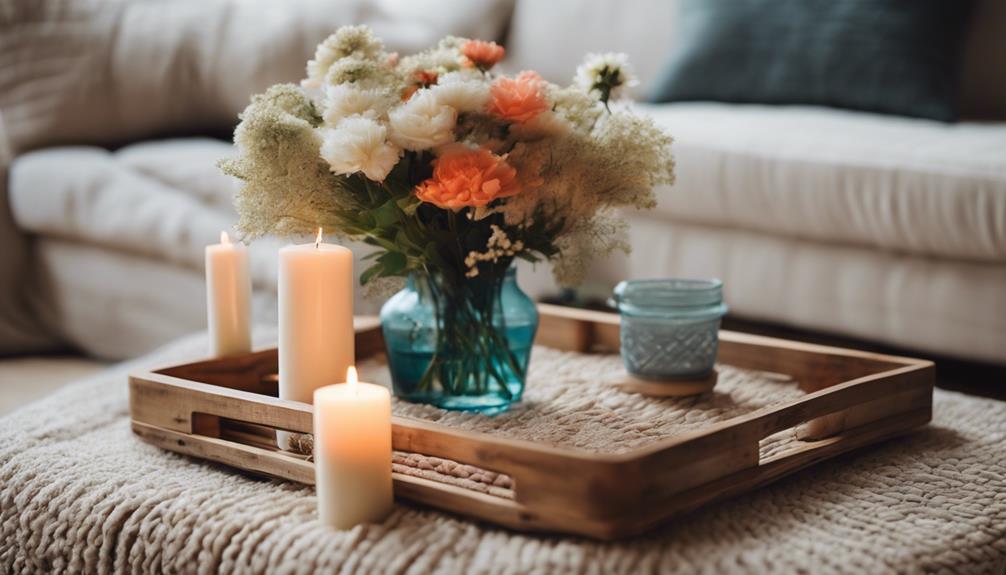
August is the perfect time to refresh your home with must-have accents. Start by elevating your walls with striking art that showcases your personality. Cozy throw pillows add texture and comfort to any space. A stylish coffee table not only acts as a centerpiece but also invites conversation. Don't forget a vibrant rug to warm up floors and create a cozy atmosphere. Brighten your rooms with unique lighting fixtures, and bring life indoors with low-maintenance plants. Finally, enhance your dining experience with chic tabletop decor. Keep going to find even more fabulous ideas that will transform your home.
Key Takeaways
- Incorporate vibrant wall art to enhance aesthetics and reflect personal style in your home this August.
- Refresh your living space with seasonal throw pillows that offer rich colors and varied textures for added comfort.
- Use stylish coffee tables as functional centerpieces that encourage social interactions and allow for decorative layering.
- Transform your interiors with rugs that define spaces and add warmth, available in diverse styles for every room.
Elevate Your Walls With Art
To truly elevate your walls, regularly incorporating enchanting wall art can dramatically transform your space and reflect your unique style. Wall art serves as a mood lifter, enhancing the aesthetic of your home while showcasing your personality.
Whether you prefer abstract pieces, serene landscapes, or quirky prints, there's a style that'll resonate with your taste and fit seamlessly into your decor items. Choosing art that complements your existing decor can help you maintain a cohesive look, accommodating various home decor trends.
Think about how each piece interacts with your furniture and color scheme—this way, your walls become engaging conversation starters for guests. Strategically placing artwork can enhance the visual interest of a room.
For instance, a large canvas above your sofa can draw the eye and create depth, while smaller pieces can be clustered together for an eclectic feel. Don't shy away from mixing sizes and styles; it can add a dynamic flair to your living space.
Cozy up With Throw Pillows
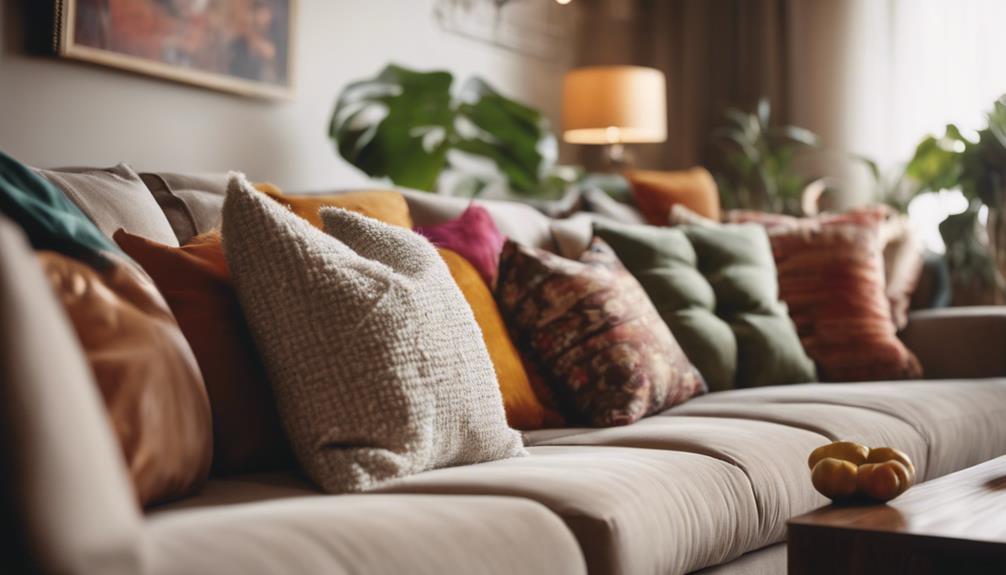
Throw pillows are your secret weapon for adding color and texture to any room.
You can easily swap them out with the seasons or layer different sizes and shapes for maximum comfort.
Let's explore how these simple accents can transform your space into a cozy retreat.
Color and Texture Options
Cozy up your space with a variety of throw pillows that showcase an array of colors, patterns, and textures. Throw pillows are perfect for adding warmth and dimension, making your living areas feel inviting and stylish. Consider opting for plush or patterned pillows to enhance the overall aesthetic.
For a fresh summer vibe, embrace vibrant colors that can brighten your interiors. These bold hues can serve as eye-catching focal points, drawing attention and creating a lively atmosphere. On the other hand, soft, neutral tones provide versatility for seasonal updates, allowing you to easily refresh your decor.
Layering different sizes and textures of throw pillows also enhances comfort while creating visual interest. Mix and match various patterns to curate a unique look that reflects your personal style. Plus, regularly swapping out pillow covers is a budget-friendly way to express your evolving tastes throughout the year.
Seasonal Swap Ideas
As summer winds down, swapping out your throw pillows for rich, warm colors can instantly bring a touch of fall into your home. Think deep oranges, burgundies, and earthy browns to set the cozy vibe for August. By adding color through your throw pillows, you can create an inviting atmosphere that reflects the changing season.
Don't just stick to one texture; mix it up! Combining velvet and knit pillows not only enhances comfort but also adds visual interest to your living spaces. Seasonal pillows featuring autumn-themed patterns—like leaves or pumpkins—serve as delightful accents that celebrate this shift.
Larger throw pillows can provide extra comfort and support, making your couches and beds more inviting for those cooler evenings. Feel free to play with sizes and shapes too. A dynamic mix of square, rectangular, and round throw pillows can create a layered look that's both stylish and welcoming.
Layering for Comfort
Enhance your living space by layering throw pillows in various textures and colors to create a warm and inviting atmosphere.
Throw pillows are an affordable way to introduce style and comfort into your home, and they allow you to easily refresh your decor as seasons change. By mixing different colors, patterns, and sizes, you can add visual interest and a cozy vibe to any room.
Consider these three essential tips for layering for comfort:
- Choose a Color Palette: Opt for a cohesive color scheme that reflects your personal style and complements your existing decor.
- Mix Textures: Combine soft fabrics like velvet with woven materials to create a dynamic and inviting look.
- Swap Seasonal Covers: Use neutral-colored pillow covers for year-round versatility, making it simple to switch out designs as the seasons change.
With these strategies, you can effortlessly elevate your space.
Don't forget, reusing pillow inserts while only purchasing new covers maximizes savings and keeps your decor fresh.
Functional and Stylish Coffee Tables
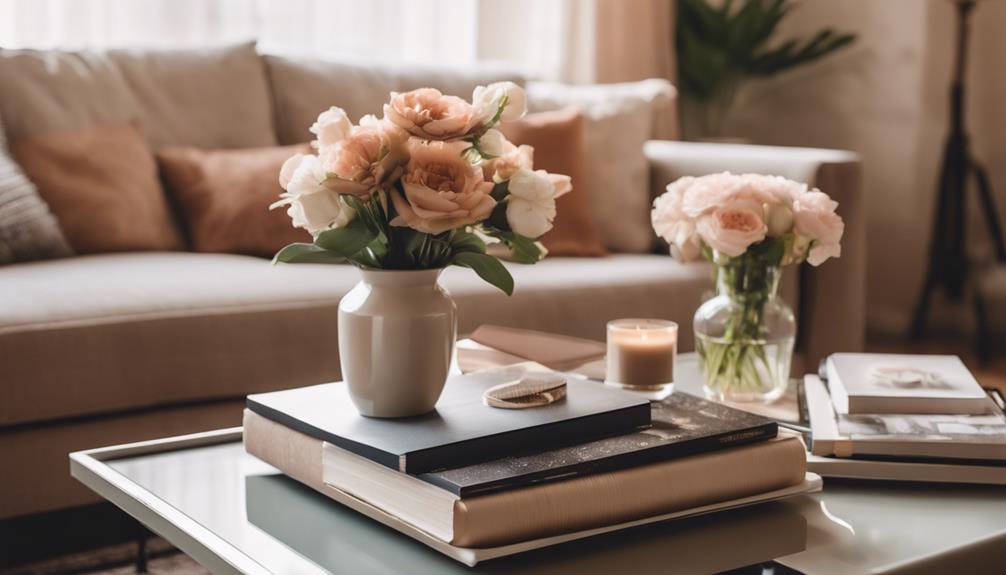
When you choose a coffee table, think of it as more than just a surface; it's a decorative centerpiece that enhances your living space.
It's also the perfect spot for social interactions, where friends gather and enjoy drinks while protecting your floors with coasters.
Plus, with designs that offer both style and storage, you can keep your space organized without sacrificing aesthetics.
Decorative Centerpiece Ideas
A stylish coffee table can transform your living space into a welcoming haven, seamlessly blending functionality with decorative flair. By implementing some thoughtful decorative centerpiece ideas, you can create a focal point that not only serves a purpose but also elevates your decor.
Here are three decor must-haves to contemplate:
- Layered Textures: Combine stacked coffee table books with a statement vase or unique bowl. This mix of height and texture creates visual interest and maintains a clean, inviting look.
- Seasonal Touches: Rotate in fresh flowers or seasonal fruits for a centerpiece that feels alive and ever-changing. This simple addition keeps your space fresh and inviting.
- Stylish Protection: Use coasters that complement your decor theme. They not only protect your table's surface but also add an extra layer of style to your centerpiece.
Enhancing Social Interactions
Creating a stylish coffee table not only amps up your decor but also sets the stage for memorable social interactions among friends and family.
A well-styled coffee table serves as a functional centerpiece that invites conversation, encouraging guests to gather around and engage. Incorporate decorative elements like bowls, books, and vases on your coffee table to enhance its aesthetics and provide interesting talking points.
Choosing a coffee table with ample surface area allows for easy placement of snacks and drinks, making it convenient for entertaining. This way, everyone feels comfortable while mingling. Regularly updating the decor—like adding seasonal items or personal treasures—keeps the space fresh and visually appealing for both you and your guests.
Additionally, utilizing coasters and trays adds an organizational flair to your coffee table, blending style with practicality. This contributes to a welcoming atmosphere that's perfect for socializing.
Practical Surface Protection
Protecting your coffee table's surface is essential for maintaining its beauty and functionality while complementing your home's style. A stylish coffee table not only serves as a functional centerpiece but also enhances your home decor essentials.
Here are three practical surface protection tips to keep your table looking great:
- Use Coasters: Always place coasters under drinks to prevent scratches and unsightly water rings. This simple habit can make a world of difference.
- Choose Durable Materials: Opt for coffee tables made from tempered glass or solid wood. These materials are resilient, ensuring your table withstands everyday use in high-traffic areas.
- Consider Multi-Functional Designs: Select a coffee table with storage compartments or lift-top features. These designs not only add practicality but also help keep your living space organized and clutter-free.
Transform Spaces With Rugs
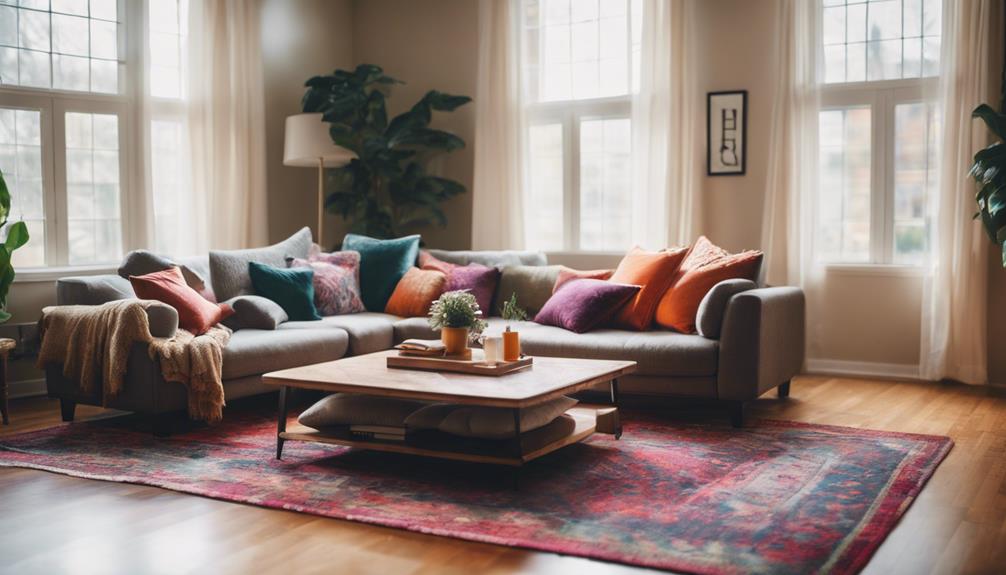
Rugs can instantly alter your spaces by adding color, texture, and warmth, making them essential elements of home decor. When you choose the right rug, it serves as a focal point that anchors your room, enhancing the overall aesthetics. With various patterns and materials available, you can define areas within open floor plans, creating distinct zones that guide the eye and enhance functionality.
Consider layering rugs for added warmth and style. This approach allows you to combine different textures and designs, showcasing your creativity. Additionally, indoor/outdoor rugs offer versatility, seamlessly changing between spaces and enhancing both your indoor and outdoor areas.
Here's a quick guide to help you choose the perfect rug for your home:
| Rug Type | Color Options | Ideal Space |
|---|---|---|
| Area Rugs | Bold, Neutral | Living Room |
| Runner Rugs | Bright, Subtle | Hallways |
| Outdoor Rugs | Vibrant, Earthy | Patios & Decks |
| Shag Rugs | Soft Pastels | Bedrooms |
| Vintage Rugs | Rich Patterns | Dining Areas |
A well-chosen rug can greatly impact your room's ambiance, making it cozy and inviting for relaxation and social interaction.
Add Charm With Decorative Accents
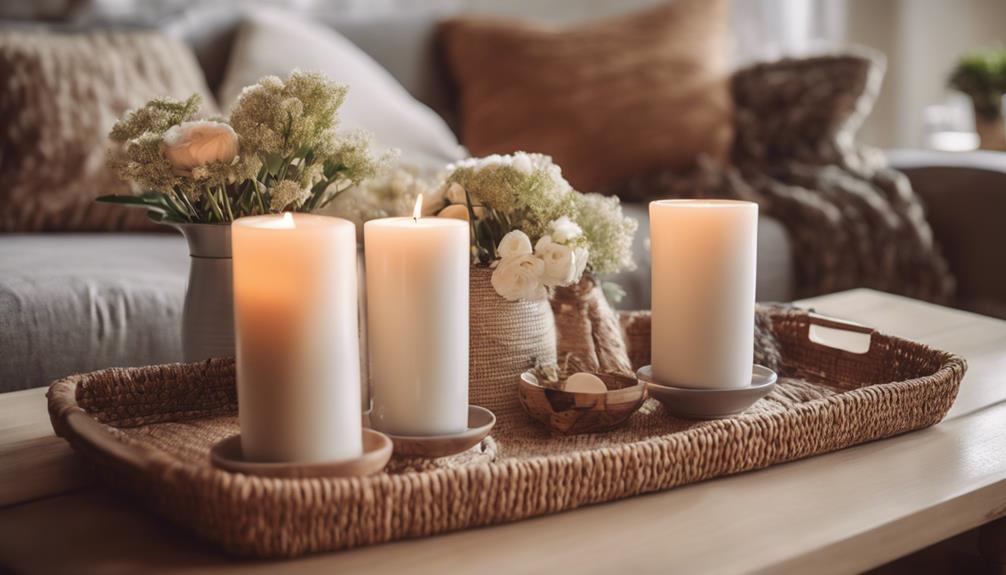
Adding decorative accents can instantly elevate your home's charm, showcasing your personal style and enhancing visual interest in every room. Whether you're looking to refresh your space or make a bold statement, these accents are essential for transforming your decor.
Here are three must-have decorative accents to contemplate:
- Mirrors: They not only create an illusion of space but also reflect light, making your room feel airier and brighter.
- Unique Bowls: These can serve as functional decor on tables or shelves, adding a touch of elegance while acting as conversation starters for your guests.
- Vases: Filled with seasonal blooms, vases bring life and color to your spaces, enhancing the overall aesthetic appeal of your home.
Incorporating decorative accents allows for easy updates to your decor, making it simple to adjust your home's vibe with the changing seasons. By choosing a curated selection of items, you can add layers of texture and character, creating focal points that draw the eye.
Stay Warm With Throw Blankets
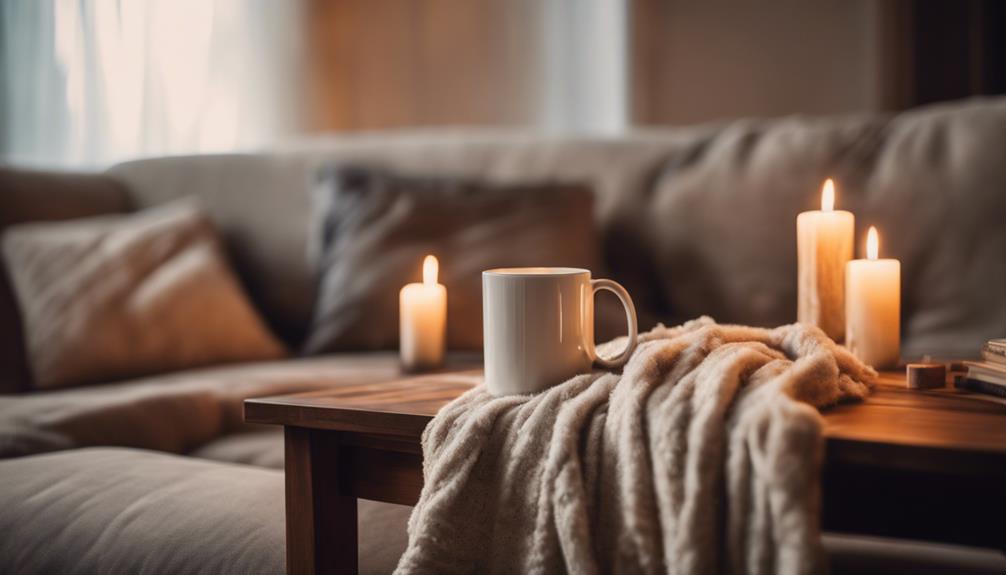
Throw blankets are your go-to solution for staying cozy as summer nights grow cooler and the fall season approaches. These versatile essentials not only provide warmth but also add a touch of style to your home. Available in various materials like cotton, wool, and knit, you can choose lightweight options that allow for easy layering without overheating during those warmer August days.
You'll love how throw blankets come in a wide array of colors and patterns, making it simple to integrate them into your existing decor. Drape them over your sofa, chair, or bed to create an inviting atmosphere perfect for cozying up with a book or enjoying a movie night with family and friends. They enhance visual interest and offer a quick way to refresh your space.
Best of all, throw blankets are budget-friendly and can be easily swapped out with the seasons. This means you can enjoy a new look without breaking the bank. So, invest in a few stylish throw blankets this August, and make your home a warm and welcoming haven as the weather shifts.
Brighten up With Lighting
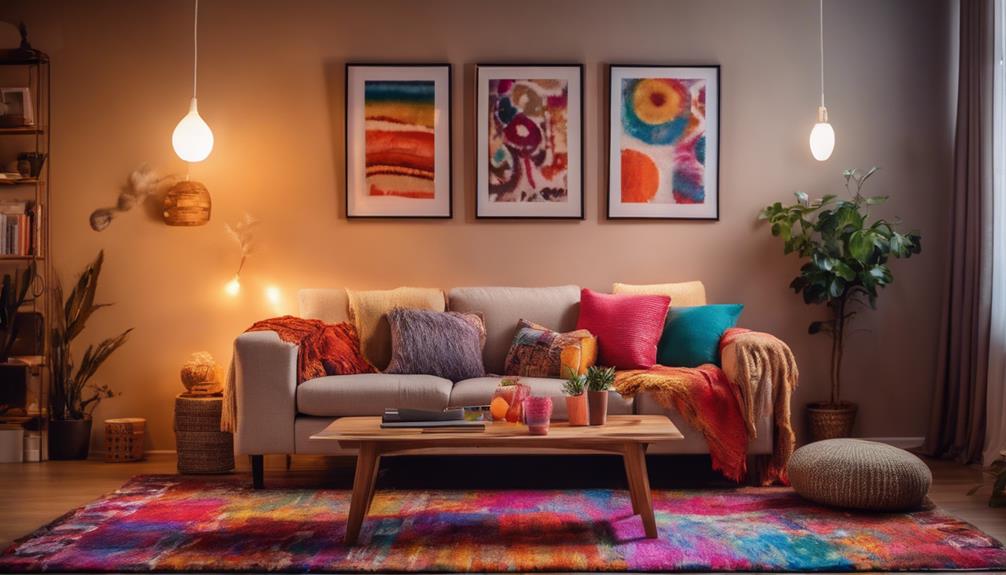
Brightening up your home with the right lighting can greatly boost your mood and enhance your decor.
By choosing energy-efficient options, you not only save on bills but also contribute to a greener planet.
Let's explore how mood-boosting fixtures and smart lighting choices can transform your space.
Mood-Boosting Light Fixtures
Mood-boosting light fixtures transform your space by combining functional and decorative elements that enhance the overall ambiance.
Whether you're looking to create a warm, inviting atmosphere or a bright, energetic vibe, the right lighting can make all the difference. Consider adding stylish floor lamps that not only illuminate but also serve as eye-catching decor pieces.
Here are three must-have mood-boosting lighting options to elevate your home:
- Adjustable Floor Lamps: These versatile fixtures allow you to change the intensity of light, helping you switch from vibrant to cozy in an instant.
- Unique Pendant Lights: Make a statement with pendant lighting that highlights your personal style while casting a soft glow across the room.
- Accent Lighting: Use lighting to draw attention to artwork or architectural features, adding depth and interest to your decor.
Energy-Efficient Lighting Options
If you're looking to reduce your energy bills while still illuminating your home beautifully, energy-efficient lighting options are the perfect solution. Switching to LED bulbs can save you up to 75% on energy costs compared to traditional incandescent bulbs. Plus, these bulbs have an impressive lifespan of up to 25,000 hours, far outlasting the standard 1,000-hour lifespan of incandescent bulbs.
When you choose Energy Star-rated lighting products, you're investing in high efficiency and performance that meet strict energy-saving guidelines. Consider adding dimmable LED and CFL bulbs to enhance your home feel while allowing you to adjust the light levels for different moods and activities. This flexibility can lead to even more energy savings.
Smart lighting systems are another fantastic option. They let you control lighting schedules and intensity remotely, which optimizes energy use and adds convenience to your life.
Bring Life With Indoor Plants
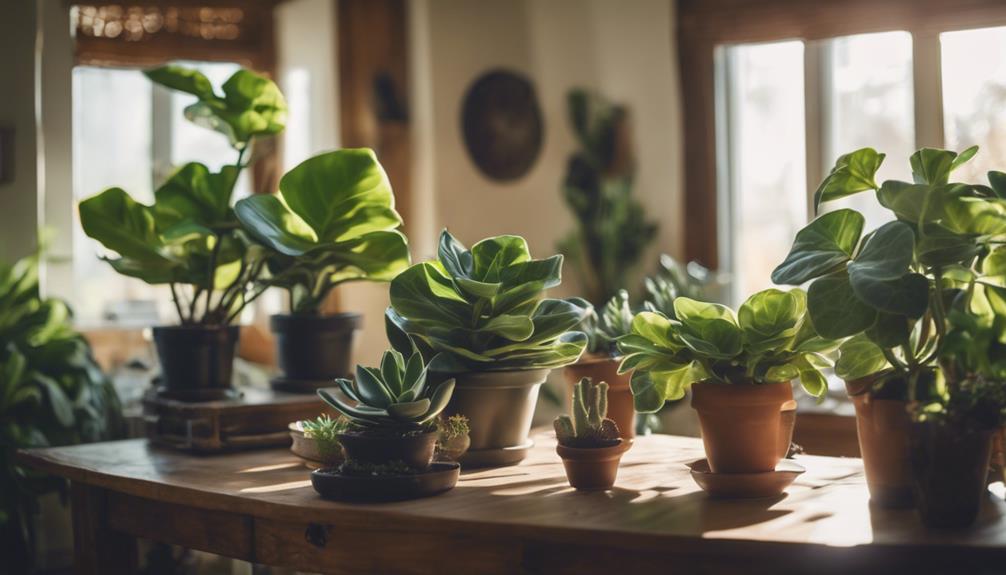
Indoor plants breathe life into your home, enhancing both aesthetics and air quality while creating a serene atmosphere. By introducing greenery, you not only beautify your space but also boost your well-being. Here are three compelling reasons to bring life with indoor plants:
- Air Quality Improvement: Indoor plants like pothos and snake plants filter toxins, increasing oxygen levels and creating a healthier environment.
- Stress Reduction: Studies show that having greenery around you can lower stress levels, promoting a calming and peaceful ambiance.
- Low-Maintenance Options: If you're new to gardening, consider succulents or ZZ plants. They require minimal care while still adding vibrant life to your space.
Strategically placing your indoor plants in awkward corners or bare areas can transform your home into a sanctuary.
Plus, choosing pots and planters in various materials and colors allows you to express your personal style while adding texture.
Frame Views With Curtains
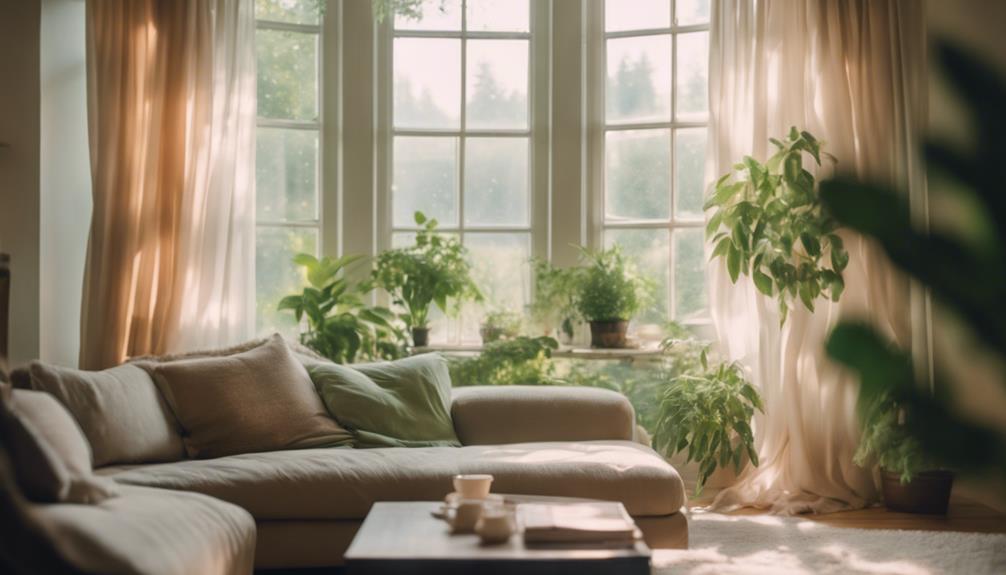
Curtains beautifully frame your windows, enhancing the views while adding elegance and sophistication to your home. With a wide variety of styles available, from sheer to bold patterned designs, you can express your personal style and complement your existing decor. Think about how these fabrics interact with your color palette; the right choice can create a cohesive look throughout your space.
When selecting curtains, consider how they control light and privacy. You can adjust them to set the perfect ambiance in your rooms, whether you want bright sunlight or a cozy, dim atmosphere. Properly hung curtains can also give the illusion of higher ceilings, making your space feel larger and more open.
Don't forget to coordinate your curtains with other accents in the room, such as decorative pillows. This thoughtful pairing can tie the entire look together, creating a harmonious feel. Take your time to choose the best fabrics and colors, as these details can greatly impact your home's overall aesthetic.
With the right curtains, you'll not only frame your views but also elevate your living space to new heights of style and comfort.
Enhance Dining With Tabletop Decor
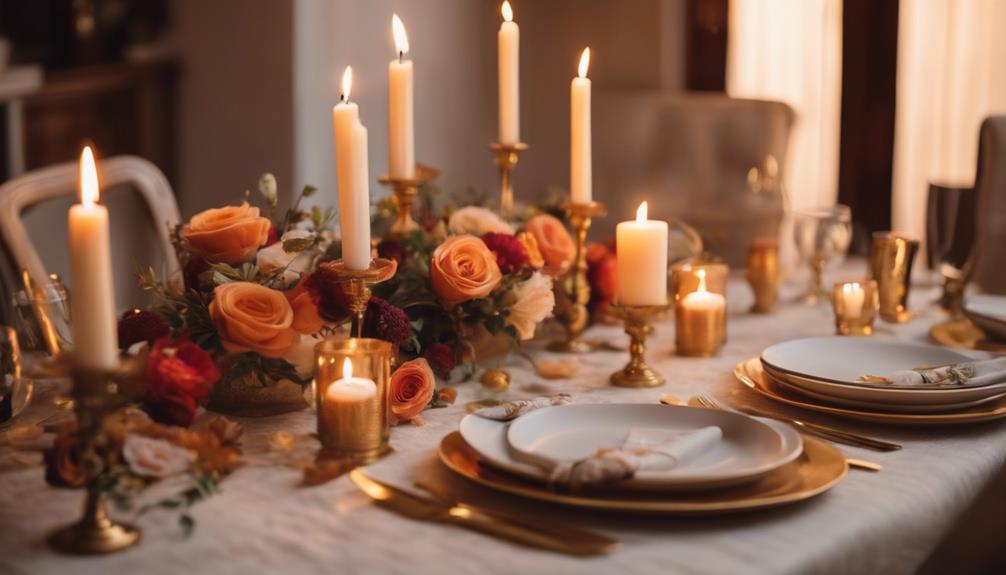
Transforming your dining experience starts with thoughtfully curated tabletop decor that reflects your personal style and invites conversation. By incorporating vibrant elements, you can create a warm and engaging atmosphere that enhances every meal.
Here are three must-have items to elevate your tabletop decor:
- Stylish Placemats: Add a pop of color to your table with unique placemats that set the tone for your dining experience. They can easily shift from room to room, making them versatile and stylish.
- Elegant Dinnerware: Choose dinnerware that showcases your taste—opt for patterns or colors that resonate with your theme. Quality pieces not only enhance functionality but also serve as conversation starters.
- Eye-Catching Centerpieces: Fresh flowers or themed decorations can transform your table into a focal point. Seasonal updates keep the decor fresh and engaging, drawing guests in.
Frequently Asked Questions
What Season to Decorate in August?
In August, you should decorate for the shift between summer and fall. Embrace bright summer colors while gradually introducing autumn tones, creating a warm, inviting atmosphere that prepares your home for the upcoming season.
What Defines Home Décor Accents?
Did you know that 75% of people believe home decor reflects their personality? Home decor accents define your space's style, enhancing aesthetics with items like vases and art, creating focal points, and adding inviting textures and colors.
Conclusion
To wrap up, these must-have home accents for August can truly transform your space into a cozy haven.
Did you know that adding just a few decorative elements can increase your home's perceived value by up to 10%? So, don't underestimate the power of well-chosen accents!
Embrace your personal style with art, plants, and lighting, and watch your home come alive.
Go ahead, make these changes and enjoy the inviting atmosphere you create!
Home Decor
Floral Vs. Plaid: Which Is Better for Your Country Living Room?
Overwhelmed by the choice between floral and plaid for your country living room? Discover which pattern will truly transform your space!
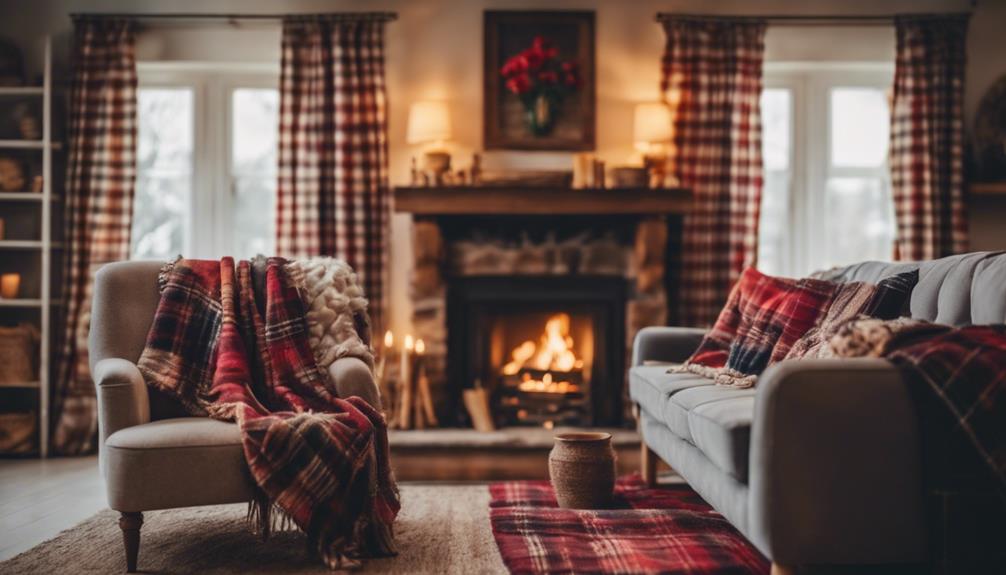
When deciding between floral and plaid for your country living room, consider the vibe you want to create. Floral patterns add warmth and vibrancy, making your space feel cheerful and inviting. On the other hand, plaid offers a more muted, rustic charm with grounded aesthetics. You can mix textures, using soft floral materials alongside sturdy plaid fabrics for balance. Don't forget to incorporate unique lighting and decorative elements like vintage items to enhance the overall feel. The choice really depends on your personal style and the atmosphere you wish to achieve in your home. Explore your options for a perfect blend!
Key Elements

When choosing between floral and plaid for your country living room, consider the key elements of color scheme, materials, and textures.
Each pattern brings its own unique vibe to the space, so think about how they can harmonize with your existing decor.
Color Scheme
A well-chosen color scheme can seamlessly blend floral and plaid patterns, enhancing the cozy charm of your country living room. Floral patterns often bring a burst of warmth and vibrancy, creating a cheerful atmosphere. In contrast, plaid designs typically favor muted colors, lending a rustic feel that complements natural materials and earthy tones.
To achieve balance, consider incorporating warm neutrals and earthy colors, such as rich browns and muted greens. These shades not only ground the overall design but also allow floral accents to shine without overwhelming the space. For instance, a bright floral cushion can pop against a muted plaid sofa, creating visual interest while maintaining harmony.
When selecting a color scheme, make certain that the hues across both floral and plaid elements are cohesive. This approach fosters a seamless blend, preventing any clash between the lively florals and structured plaids.
Materials
Choosing the right materials is key to harmonizing floral and plaid patterns in your country living room, as each fabric type contributes to the overall aesthetic and comfort of the space.
Floral patterns often feature vibrant colors and intricate designs, typically crafted from soft materials like cotton or linen. These fabrics bring warmth and liveliness, making them perfect for soft furnishings like cushions and curtains.
On the other hand, plaid patterns provide a classic, cozy vibe, usually made from more durable materials such as wool or tweed. These fabrics add rustic charm and are ideal for heavier items like throws and upholstery, enhancing the traditional feel of your room.
When you consider wall treatments, floral wallpapers can create a cheerful backdrop, while plaid can lend a grounded, timeless look, especially in accent walls.
To achieve a balanced and inviting space, mix these materials thoughtfully. Use floral patterns to soften the boldness of plaid, ensuring that both styles complement each other.
Textures
To create a warm and inviting country living room, mixing a variety of textures—from soft cotton and wool to natural elements like wood and stone—plays an essential role in crafting a cozy atmosphere. Soft textiles like cotton or wool for upholstery not only provide comfort but also enhance the overall warmth of your space.
Incorporating natural materials, such as weathered wood and stone, contributes to the rustic charm that defines country living. You can achieve depth and visual interest by layering various textures, like chunky knit blankets paired with plaid pillows. This layering enhances the cozy atmosphere you're aiming for.
Vintage furniture pieces add unique textures and history to your decor, creating a personalized and inviting environment. Consider mixing finishes, like distressed metals alongside soft fabrics, to balance the rustic aesthetic while introducing a touch of modernity.
Essential Fixtures and Furniture
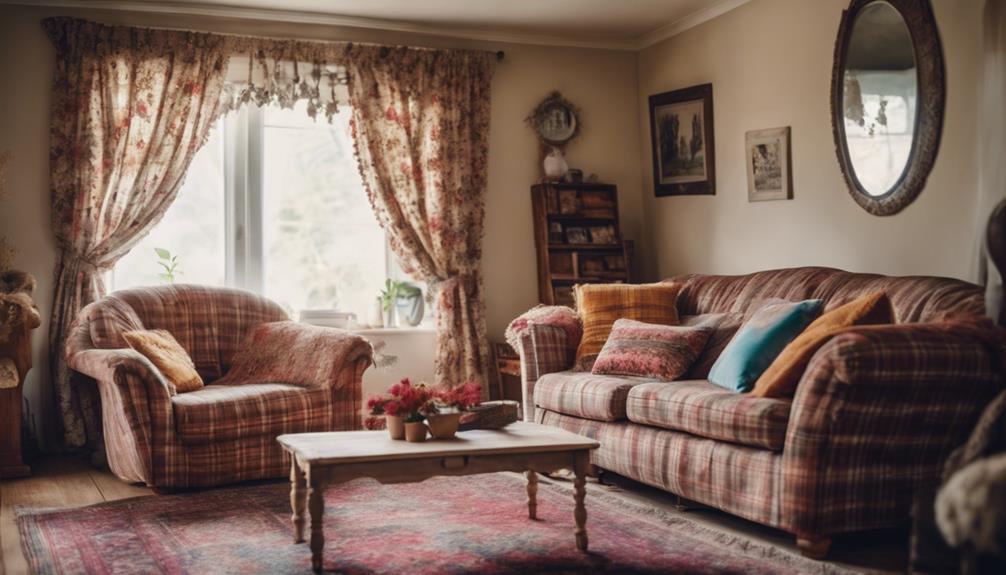
When it comes to essential fixtures and furniture for your country living room, you'll want to focus on key pieces that enhance the overall aesthetic.
A vintage farmhouse dining table, an antique sideboard with character, and a rustic farmhouse coffee table can create a warm and inviting atmosphere.
These elements not only complement floral or plaid designs but also reinforce the rustic charm you're aiming for.
Vintage Farmhouse Dining Table
A vintage farmhouse dining table adds a touch of rustic charm and durability to your country living room, making it an essential piece for both family meals and gatherings.
These tables often feature solid wood construction that emphasizes their durability while enhancing the rustic aesthetic of your space. With their distressed finishes, they not only provide a sense of history but also exude warmth, making your home feel cozy and inviting.
You'll find that vintage farmhouse tables come in various sizes, perfectly accommodating everything from intimate dinners to larger family gatherings. Their sturdy legs and unique design elements, like turned legs or trestle bases, enhance both functionality and style, ensuring they stand out in any country home.
Plus, incorporating a vintage farmhouse dining table into your decor allows you to mix and match with other traditional elements, such as mismatched chairs or colorful table settings, creating a welcoming atmosphere.
In essence, a vintage farmhouse dining table is more than just furniture; it's a centerpiece that brings people together, making it an indispensable addition to your country living room.
Antique Sideboard With Character
An antique sideboard often becomes the focal point of your country living room, offering both style and practical storage solutions. This piece of antique furniture can serve as a functional centerpiece, allowing you to store items while displaying vintage dishes or cherished family heirlooms. Its unique character often comes from distressed finishes and historical craftsmanship, which add a rustic touch that enhances the room's overall aesthetic.
Made from solid wood, many antique sideboards provide durability and a timeless appeal, perfectly complementing other natural materials in your decor. Selecting a sideboard with intricate carvings or distinctive hardware not only enhances the vintage style but also makes it a conversation starter for your guests.
Rustic Farmhouse Coffee Table
Building on the charm of an antique sideboard, a rustic farmhouse coffee table serves as a practical yet stylish centerpiece in your country living room. Typically crafted from reclaimed wood, these coffee tables emphasize sustainability while showcasing unique character in every piece. The distressed finish not only enhances the vintage aesthetic but also complements other elements within farmhouse interiors.
When choosing your coffee table, consider the size to guarantee it fits comfortably within your seating area. It should allow for easy access and flow, making your living space inviting. Many rustic farmhouse coffee tables come equipped with functional features like storage drawers or shelves, perfect for keeping your cozy area organized.
You can also personalize your choice with various styles, such as farmhouse chic or industrial farmhouse, allowing the coffee table to seamlessly blend with your overall decor. Whether you're enjoying a cup of coffee or entertaining guests, a rustic farmhouse coffee table provides both functionality and charm, making it an essential fixture in your country living room.
Lighting Ideas
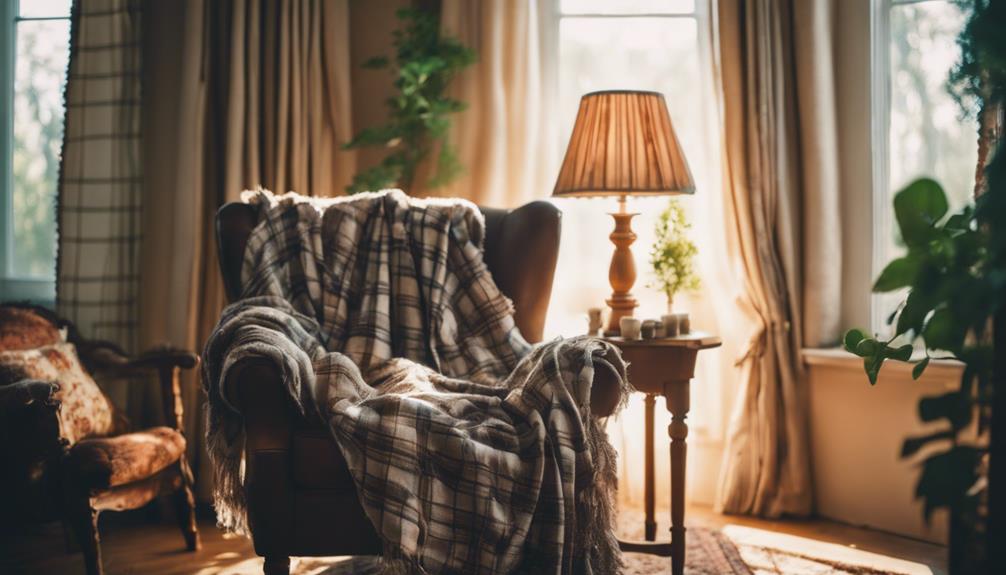
When it comes to lighting your country living room, think about incorporating rustic lanterns for that cozy ambiance.
Vintage Edison bulb fixtures and antique-style table lamps can add a touch of charm, while charming candle chandeliers create a warm glow for intimate gatherings.
Layering these elements will enhance the overall aesthetic and make your space feel inviting.
Rustic Lanterns for Ambient Lighting
Rustic lanterns create a warm, inviting glow that perfectly complements the natural materials and cozy decor of your country living room. These charming fixtures enhance ambient lighting by providing a soft radiance that makes your space feel welcoming and comfortable. You can find rustic lanterns in various styles, including wrought iron, wood, and glass, allowing you to choose options that resonate with your personal taste.
Hang them from ceilings to illuminate your room or place them on tables for added visual interest. Many rustic lanterns come equipped with flickering LED candles or traditional candle placements, giving you a safe yet authentic glow reminiscent of old-world charm. By incorporating these lanterns into your decor, you can create focal points that highlight architectural features like exposed beams or stone fireplaces.
Don't hesitate to mix sizes and styles of rustic lanterns; this adds depth and texture to your living room, helping create a layered and inviting atmosphere. With the right placement, rustic lanterns can transform your space into a cozy retreat, making it the perfect spot for relaxation and gatherings.
Vintage Edison Bulb Fixtures
Vintage Edison bulb fixtures effortlessly bring a nostalgic charm to your country living room, enhancing its inviting atmosphere with their warm glow and classic design.
These fixtures, featuring exposed filaments, emit a soft light that creates a cozy atmosphere perfect for relaxation or entertaining guests.
You'll find vintage Edison bulb fixtures in various styles, including pendant, chandelier, and wall sconces, making it easy to complement your space's rustic charm.
When strategically placed, they can serve as a focal point, drawing attention to your room's architectural features like exposed beams or rustic furnishings.
If you're looking for an eco-friendly option, consider energy-efficient LED Edison bulbs.
They maintain the vintage look while reducing energy consumption and extending bulb life, allowing you to enjoy the aesthetic without compromising on sustainability.
Incorporating these fixtures into your lighting design not only enhances the ambiance but also ties together diverse elements of your decor.
Whether you prefer a traditional or modern take on country style, vintage Edison bulb fixtures can elevate your living room, creating a warm and inviting space that reflects your personal taste.
Antique-style Table Lamps
While vintage Edison bulb fixtures set the mood, incorporating antique-style table lamps can further enhance the charm and sophistication of your country living room. These lamps often feature intricate designs and materials like brass, porcelain, or stained glass, adding a timeless elegance that complements rustic decor. Their unique shades, crafted from vintage fabrics or glass, can elevate the character of your space, offering decorating ideas that truly stand out.
Antique-style table lamps aren't just decorative; they provide both ambient and task lighting, helping to create a cozy atmosphere. Think about placing them on side tables or console tables to add warmth and functionality. When selecting the right lamps, pay attention to their height and scale in relation to your furniture to maintain a harmonious balance in your room.
Furthermore, these lamps showcase craftsmanship from different eras, making them conversation starters and focal points in your living room. By choosing antique-style table lamps, you'll not only illuminate your space but also infuse it with a touch of nature and history, enriching the overall ambiance of your country living room.
Charming Candle Chandeliers
Candle chandeliers can transform your country living room with their warm, inviting glow and charming designs that highlight natural materials and vintage decor. These fixtures are perfect for enhancing the rustic aesthetic of your space, providing a cozy ambiance that encourages gatherings and relaxation.
When you choose charming candle chandeliers, look for options featuring intricate designs, such as wrought iron or distressed wood. These elements add character and elegance, making your chandelier a stunning focal point. Opting for chandeliers that hold multiple candles guarantees your rustic living room is well-lit, creating an inviting atmosphere.
Consider varying the heights of your candle chandeliers to add visual interest and depth to your decor. This layering technique enhances the texture typical of country living rooms, making them feel more dynamic.
Decorative Elements
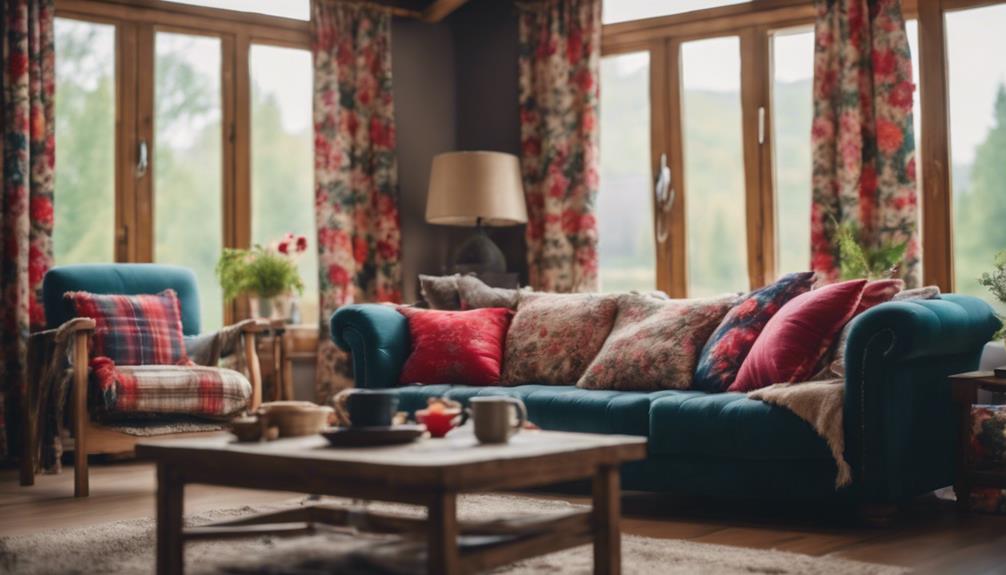
When it comes to decorative elements, think about incorporating handcrafted ceramic vases, vintage floral wall art, and woven wicker wall baskets.
These pieces not only enhance the country charm but also reflect your personal taste.
Handcrafted Ceramic Vase
How can handcrafted ceramic vases enhance the charm of your country living room? These unique decor pieces bring an artisanal charm that perfectly complements your rustic decor.
With their earthy glazes and textures, handcrafted ceramic vases introduce a natural feel that resonates with the warmth of your space.
You can use them as focal points by filling them with fresh flowers or dried arrangements, instantly adding color and life to the room. The beauty of these vases lies in their versatility; they come in various sizes, shapes, and colors, allowing you to create arrangements that reflect your individual style.
Incorporating handcrafted ceramic vases into your decor not only elevates the aesthetic but also adds a personal touch. Each piece showcases your appreciation for craftsmanship and supports local artisans, making your home feel more connected to the community.
Whether you opt for a single statement vase or a collection, these elements will enhance the overall ambiance of your country living room, making it a cozy retreat that tells your unique story.
Vintage Floral Wall Art
Vintage floral wall art adds a touch of nostalgia and warmth, making it a perfect focal point for your country living room. These art pieces often showcase intricate patterns and muted tones, which evoke tranquility and a connection to nature.
When you choose vintage floral wall art, you enhance the overall color palette of your space, allowing it to blend seamlessly with soft furnishings and wood accents. Incorporating these pieces into your decor not only complements rustic decor but also adds character and individuality to the room.
You can easily mix and match vintage floral art with other styles, like plaid or gingham, to create a layered and inviting aesthetic. This versatility allows you to express your personal style while maintaining a cozy atmosphere.
When selecting vintage floral wall art, consider how it reflects your tastes and the mood you want to create. By thoughtfully integrating these elements, you can transform your country living room into a warm, welcoming haven that feels uniquely yours.
Embrace the charm of vintage floral wall art, and let it breathe life into your decor!
Woven Wicker Wall Baskets
Woven wicker wall baskets bring a unique blend of texture and warmth to your country living room, instantly enhancing its cozy charm. These versatile decorative elements can serve dual purposes, acting as both storage solutions for items like magazines or throws and as stylish accents that complement rustic decor.
Available in various sizes and shapes, you can arrange woven wicker wall baskets in groupings to create an eye-catching focal point on a blank wall. This arrangement not only adds visual interest but also brings a sense of balance to the space. Incorporating natural materials like wicker helps connect your indoor area with nature, aligning perfectly with the essence of country living design principles.
Another advantage of woven wicker wall baskets is their adaptability. You can easily style them with seasonal decor, such as dried flowers or greenery, making them a dynamic addition to your living room decor.
Flooring
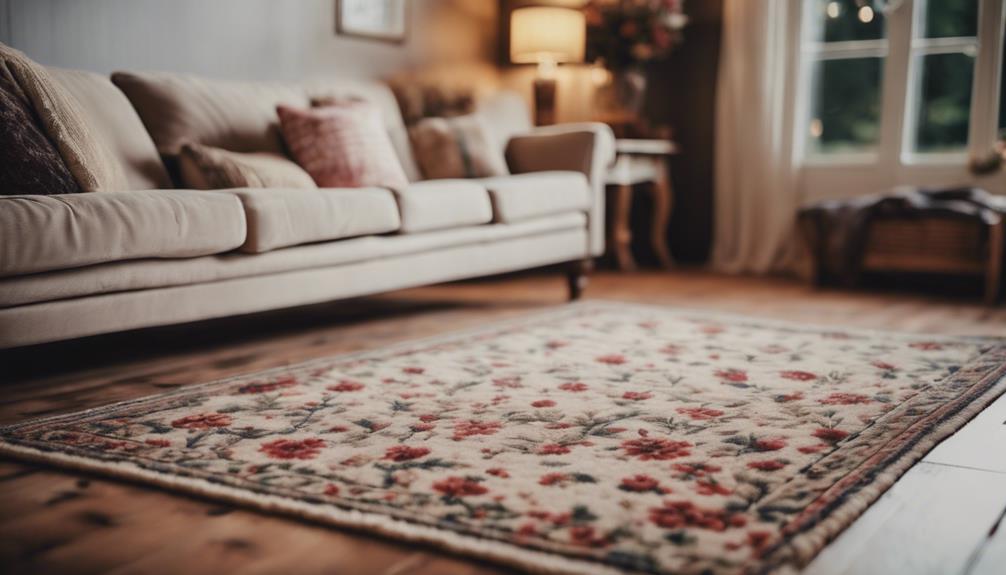
When it comes to flooring for your country living room, you can't go wrong with options like reclaimed barnwood plank or wide plank oak, both of which bring a rustic charm.
Hand-scraped maple hardwood offers a classic touch that pairs beautifully with floral and plaid patterns.
Choosing the right flooring will set the tone for your space, so consider your style carefully.
Reclaimed Barnwood Plank Flooring
Reclaimed barnwood plank flooring brings a unique blend of sustainability and rustic charm to your country living room, making it a standout choice for your home's aesthetic. This flooring option not only reduces waste but also infuses your space with character and history through its weathered wood appearance. Each plank showcases natural beauty with variations in color and texture, creating a cozy atmosphere that complements both floral and plaid design elements.
Choosing reclaimed barnwood means you're investing in durability. Its age and history often make it more resilient than new wood, ensuring it can withstand the everyday wear and tear of family life. Plus, the rustic vibe of reclaimed wood pairs beautifully with country living room decor, enhancing the overall warmth of your space.
Moreover, installing reclaimed barnwood flooring can increase your home's value. Buyers often seek authentic, rustic charm in country-style interiors, and this flooring delivers just that.
Wide Plank Oak Flooring
Wide plank oak flooring offers a perfect blend of durability and rustic elegance, making it an ideal choice for your country living room. This flooring type is known for its strength, perfect for high-traffic areas where family and friends gather. The natural grain patterns and rich color variations of oak enhance the rustic charm of your space, creating a warm and inviting atmosphere.
With widths ranging from 5 to 12 inches, wide plank oak flooring adds a sense of spaciousness and visual interest to your living room. You can easily incorporate this flooring into various country living room ideas, pairing it with wood accents to emphasize the natural elements in your decor. Plus, oak flooring comes in various stains and finishes, allowing you to customize the look to fit your desired aesthetic—whether you prefer a light farmhouse vibe or a dark, cozy retreat.
Maintenance is a breeze, too. Regular sweeping and occasional refinishing will keep your wide plank oak flooring looking stunning for years to come. In short, this flooring option perfectly balances beauty and practicality, making it a standout choice for your country living room.
Hand-scraped Maple Hardwood Flooring
Hand-scraped maple hardwood flooring brings a textured finish that enhances the rustic charm of your country living room, offering a stylish alternative to wide plank oak. This flooring's unique hand-scraped finish varies in depth and design, giving your space a personalized look that radiates character.
In country-style living, the fine, uniform grain pattern of maple naturally complements both floral and plaid decor, creating a cohesive aesthetic that ties your room together. Plus, maple is one of the hardest domestic hardwoods, making it a durable choice for high-traffic areas. You won't have to worry about wear and tear, ensuring your flooring looks great for years to come.
Maintaining hand-scraped maple flooring is straightforward. Regular sweeping keeps it clean, while occasional refinishing preserves its beauty and durability over time.
Choosing this type of flooring not only enhances the rustic appeal of your living space but also aligns with your practical needs. So, if you're aiming for a cozy, inviting atmosphere in your country living room, hand-scraped maple hardwood flooring might just be the perfect fit.
Conclusion
Ultimately, whether you choose floral or plaid for your country living room depends on your personal style and the vibe you want to create.
Floral patterns can bring a soft, romantic touch, while plaid adds a cozy, rustic feel.
Remember to balance your choice with essential fixtures, lighting, and decorative elements that enhance the overall look.
Whichever you pick, make sure it reflects your personality and makes your living space inviting and warm.
Enjoy decorating!
-
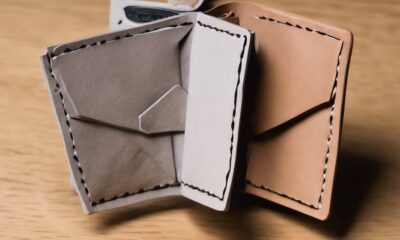
 Vetted1 month ago
Vetted1 month ago14 Best Personalized Father's Day Gifts for Your Husband – Show Him You Care
-

 Alfresco1 month ago
Alfresco1 month agoAlfresco Stacker Doors: Seamless Indoor-Outdoor Living!
-

 Craft and Textiles3 months ago
Craft and Textiles3 months ago15 Best Places to Buy Appliances for Your Home – Top Retailers Reviewed
-

 Decorative Throws3 months ago
Decorative Throws3 months agoIs It Better to Dry Clean Blankets?
-

 Tableware and Dining Accessories3 months ago
Tableware and Dining Accessories3 months agoWhat Is the Meaning of the Word Tableware
-
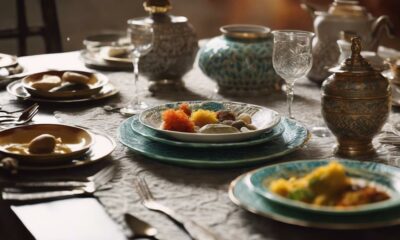
 Tableware and Dining Accessories3 months ago
Tableware and Dining Accessories3 months agoWhat Is the Hindi Meaning of Tableware
-

 Craft and Textiles3 months ago
Craft and Textiles3 months ago15 Best Cordless Mowers for Effortless Lawn Care – Top Picks of 2024
-

 Yarn3 months ago
Yarn3 months agoIs Yarn Natural or Manmade? Unravel the Truth























